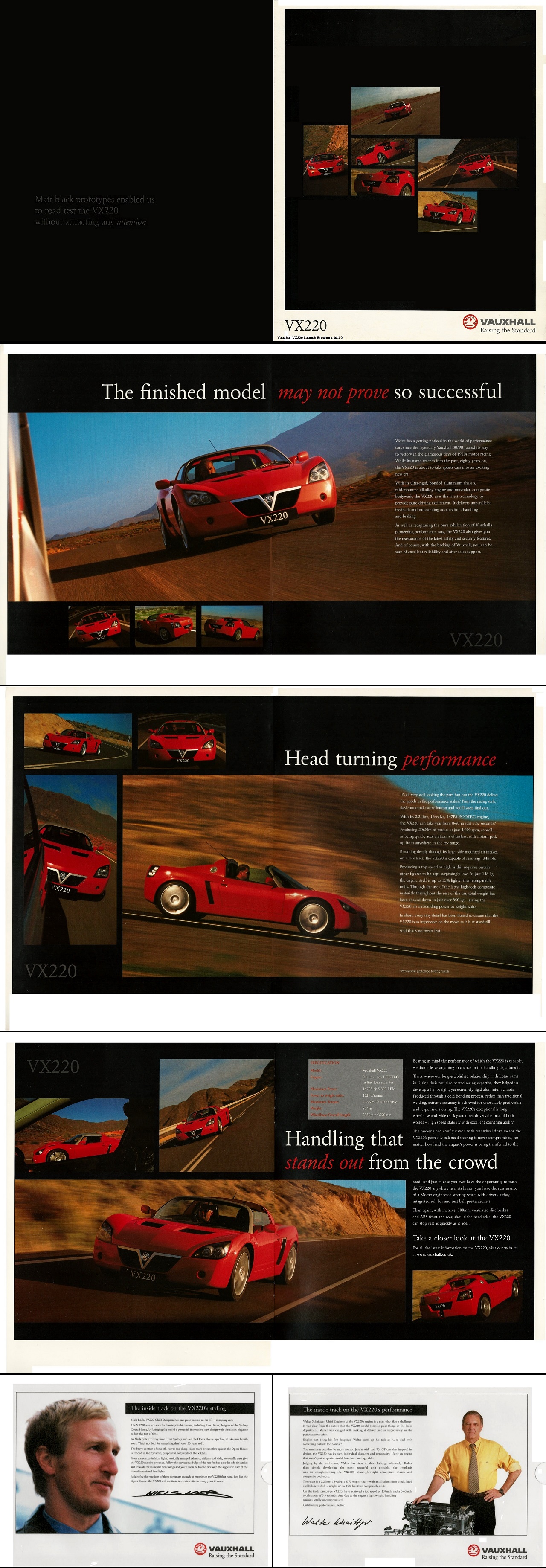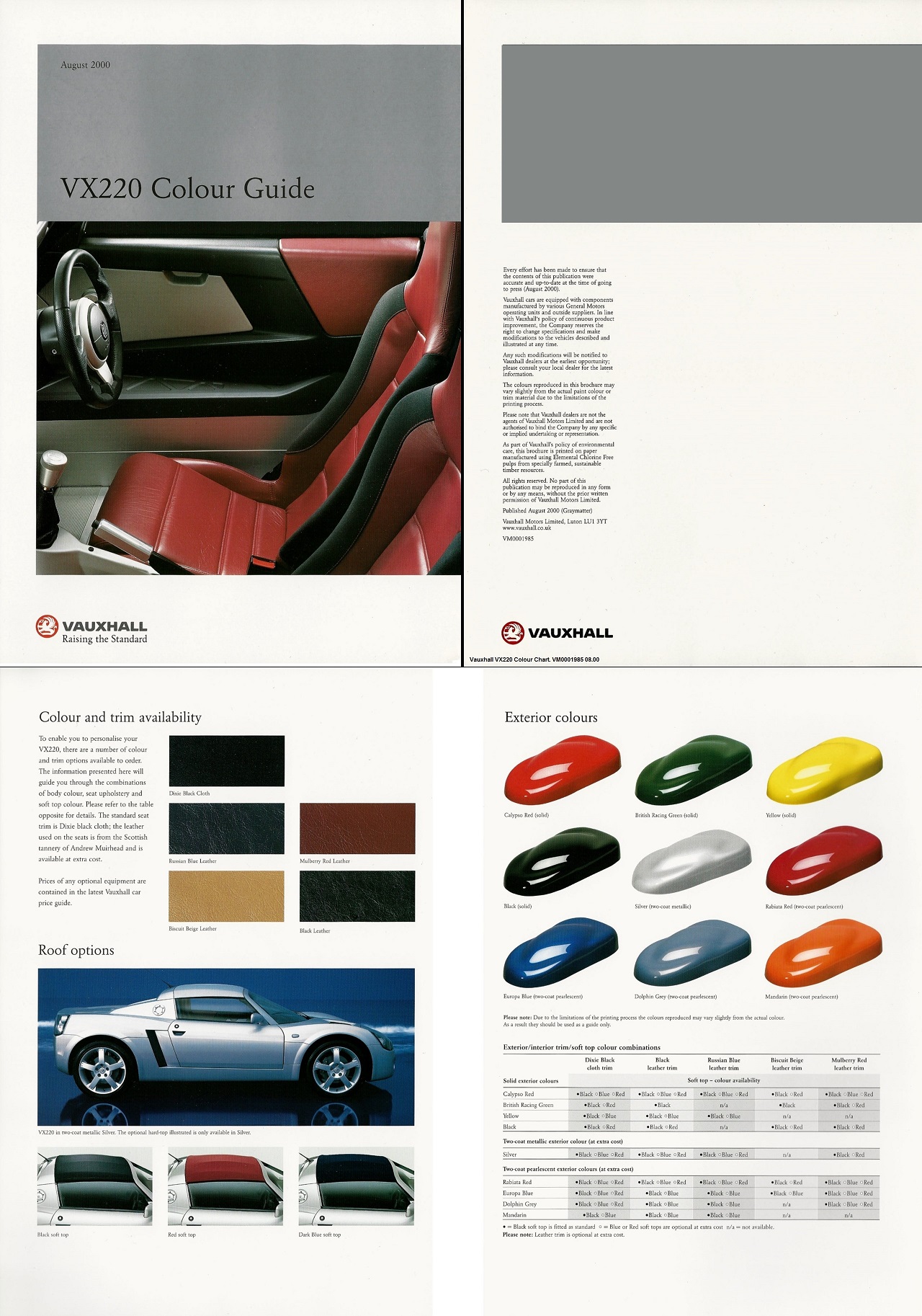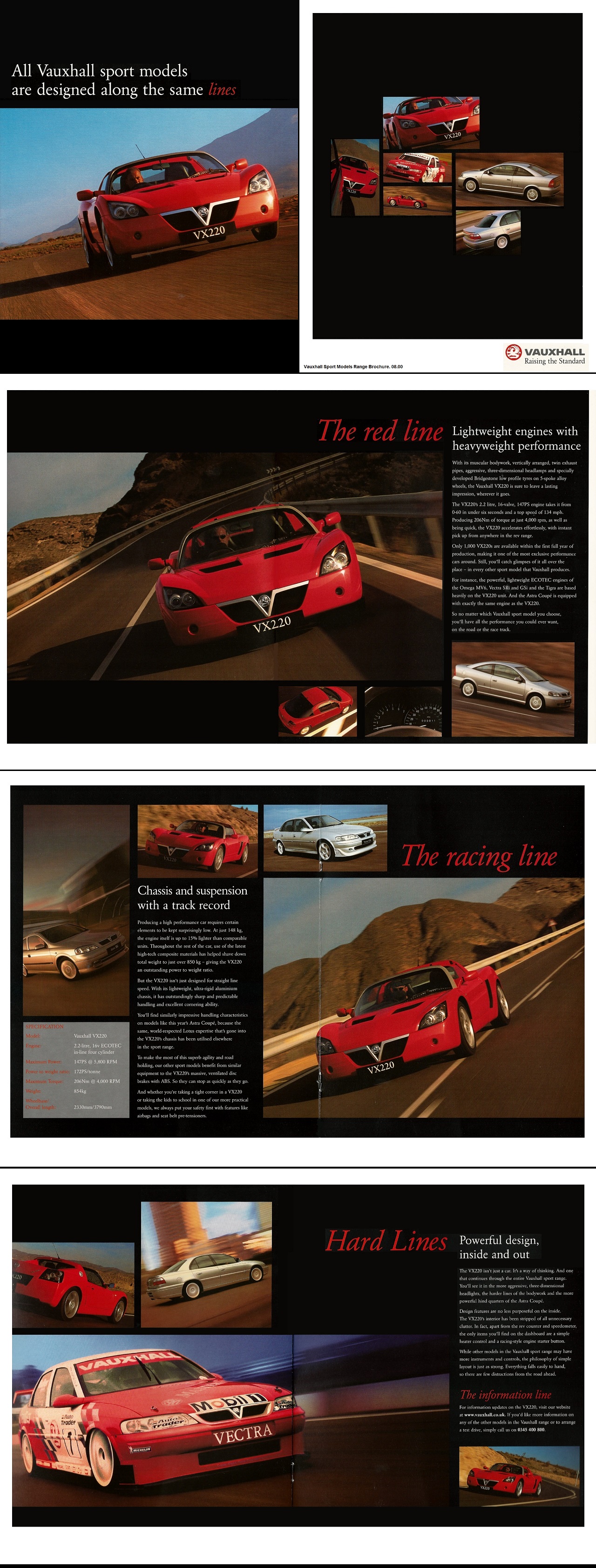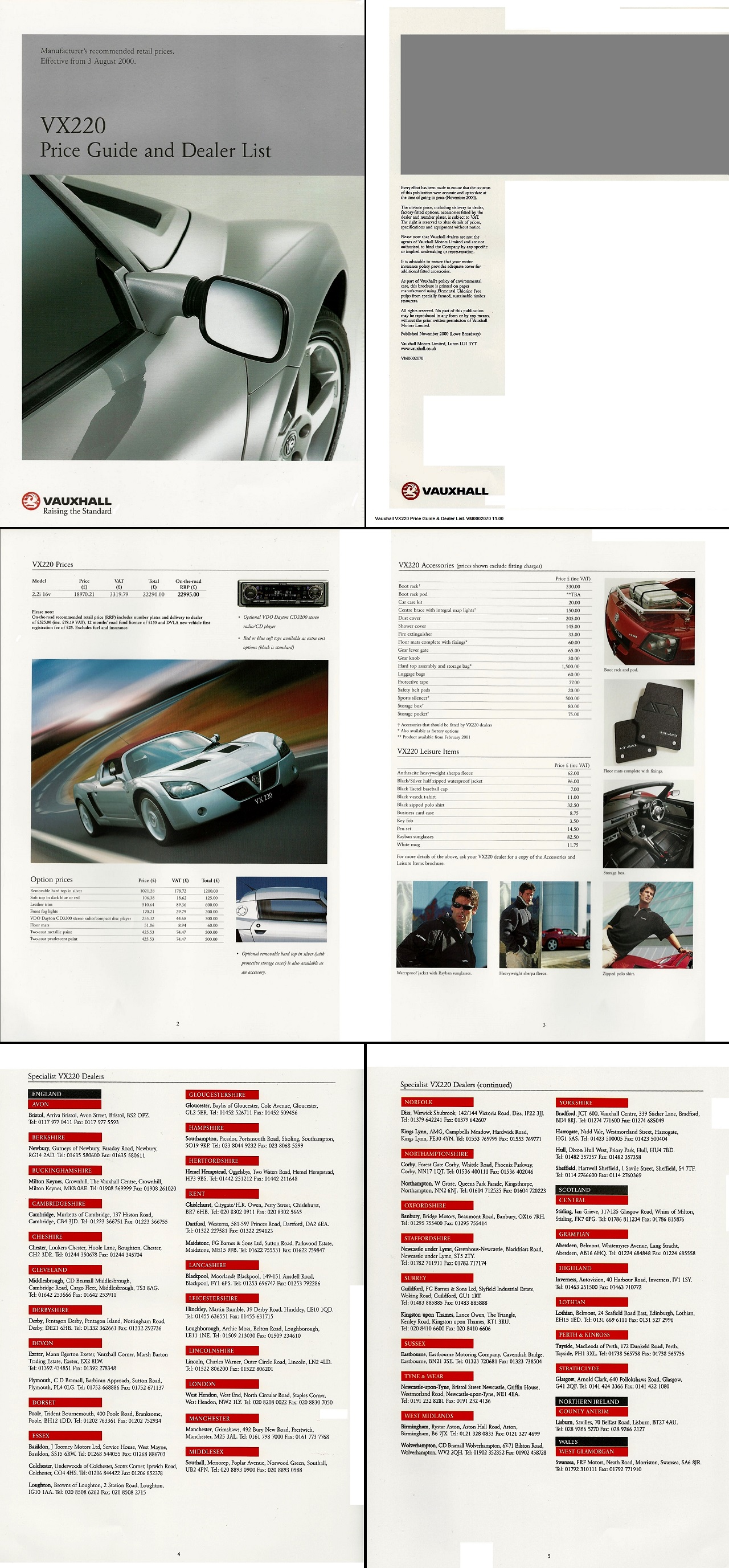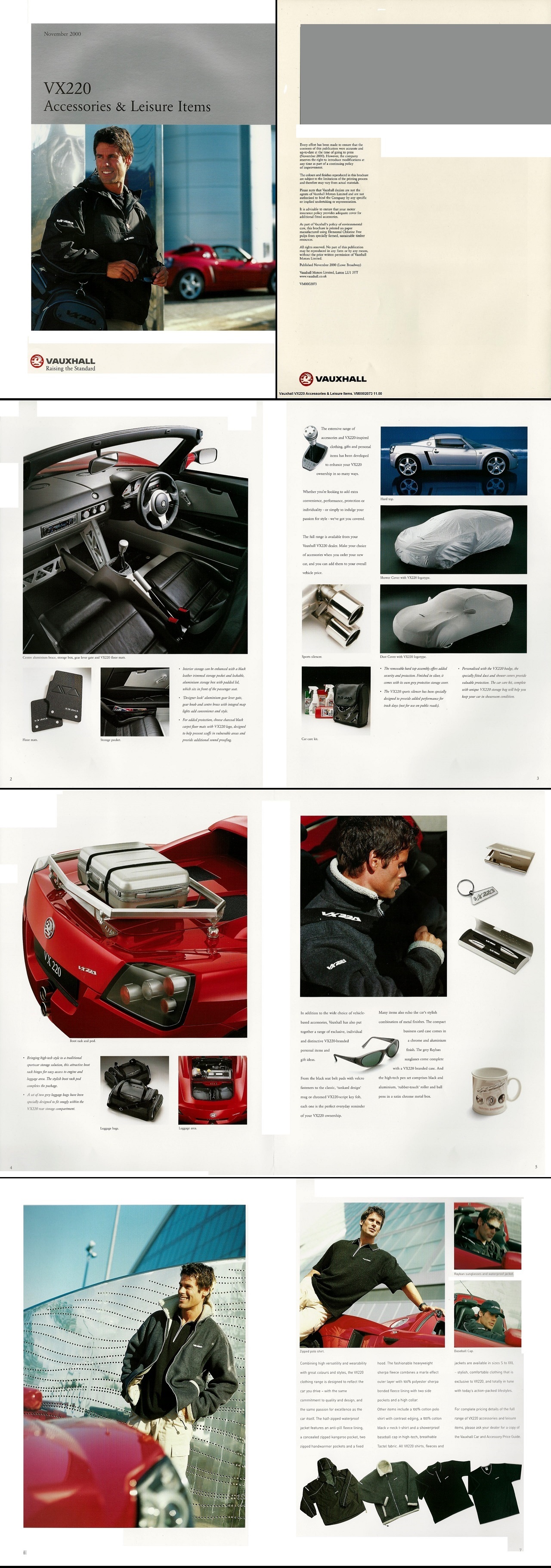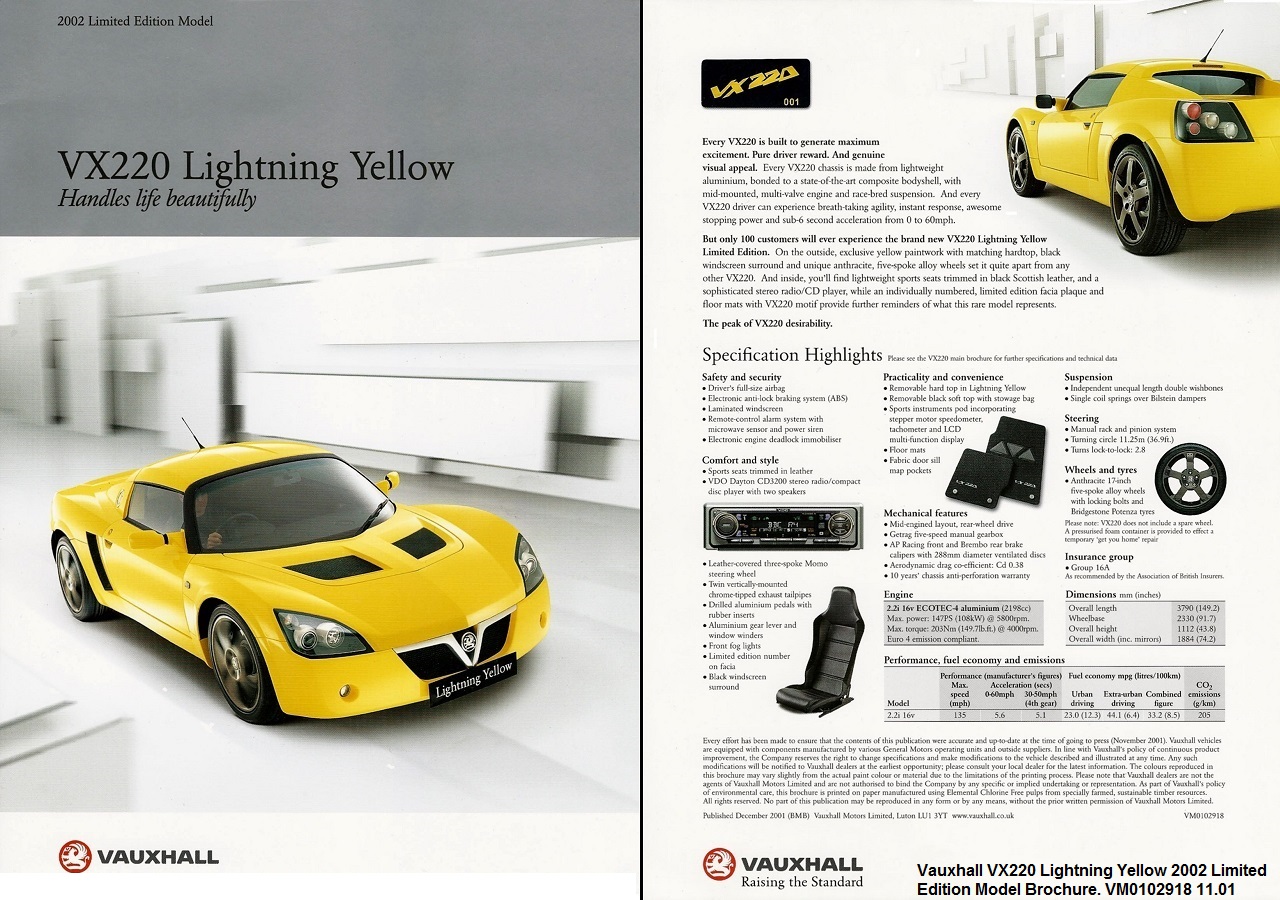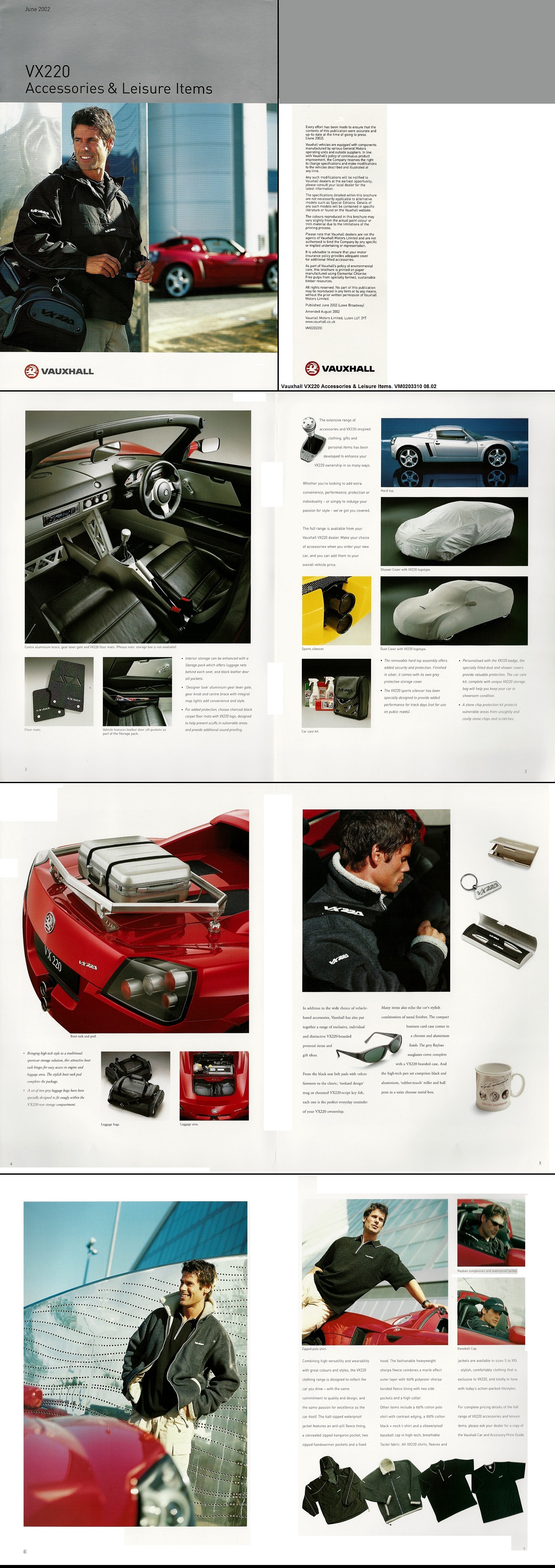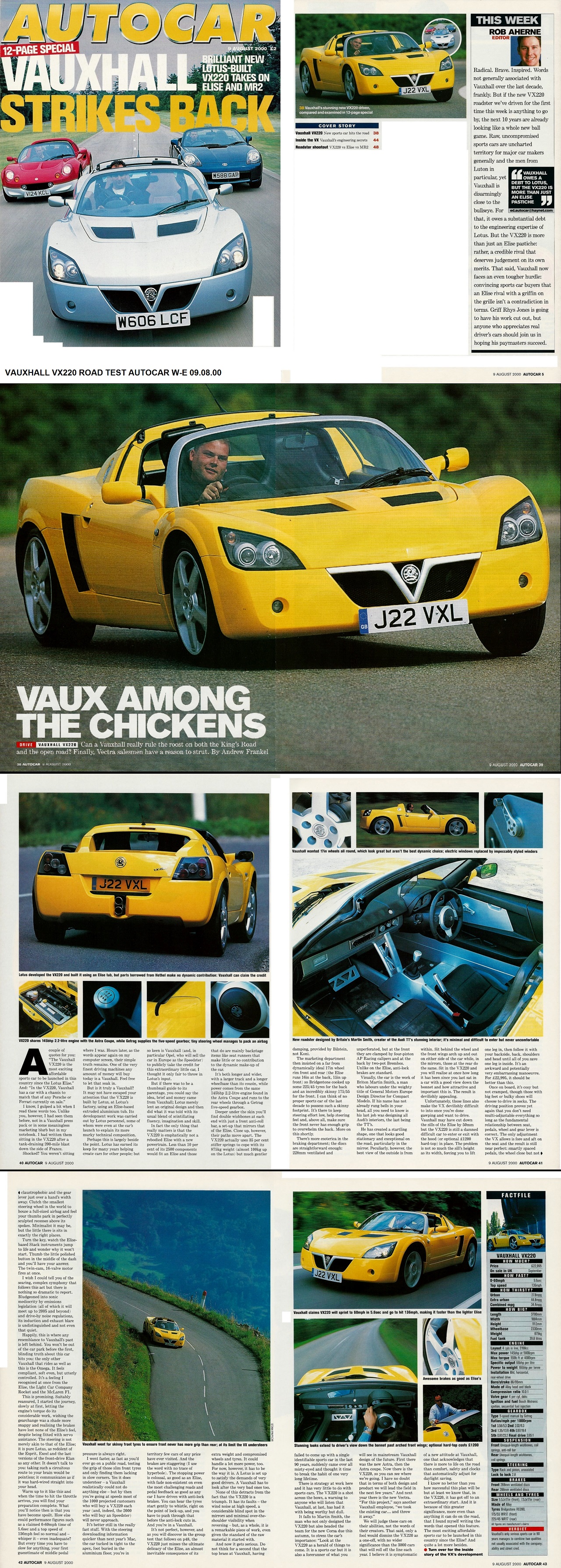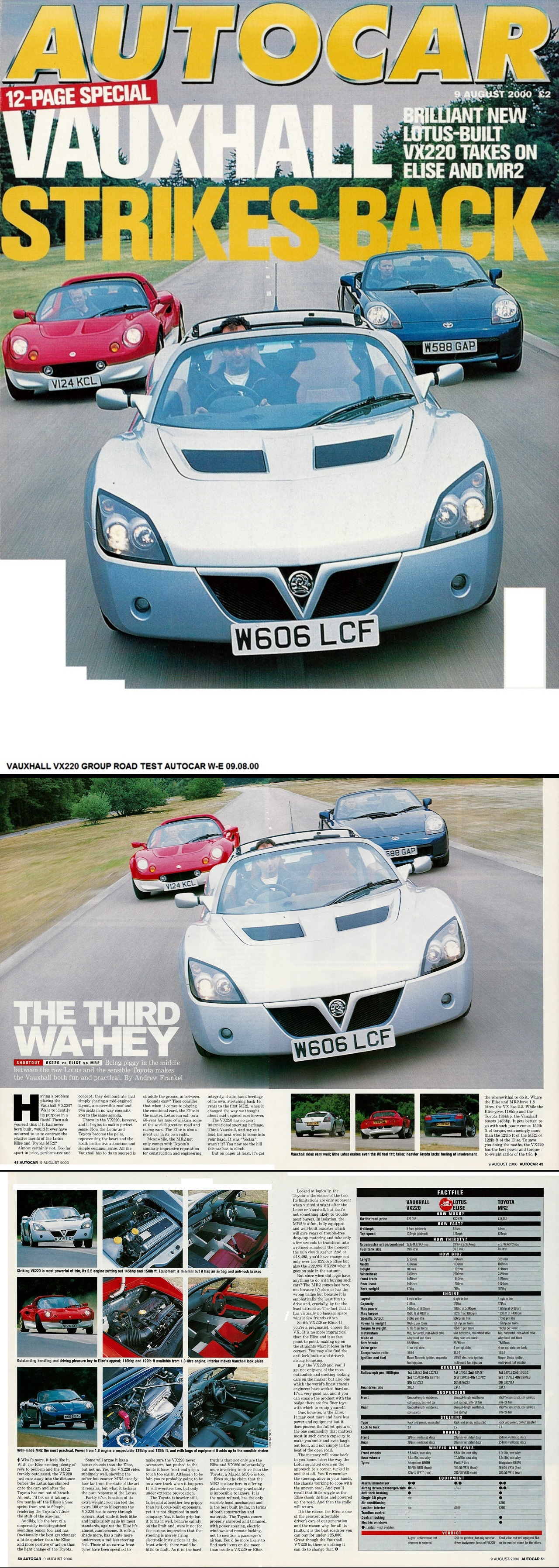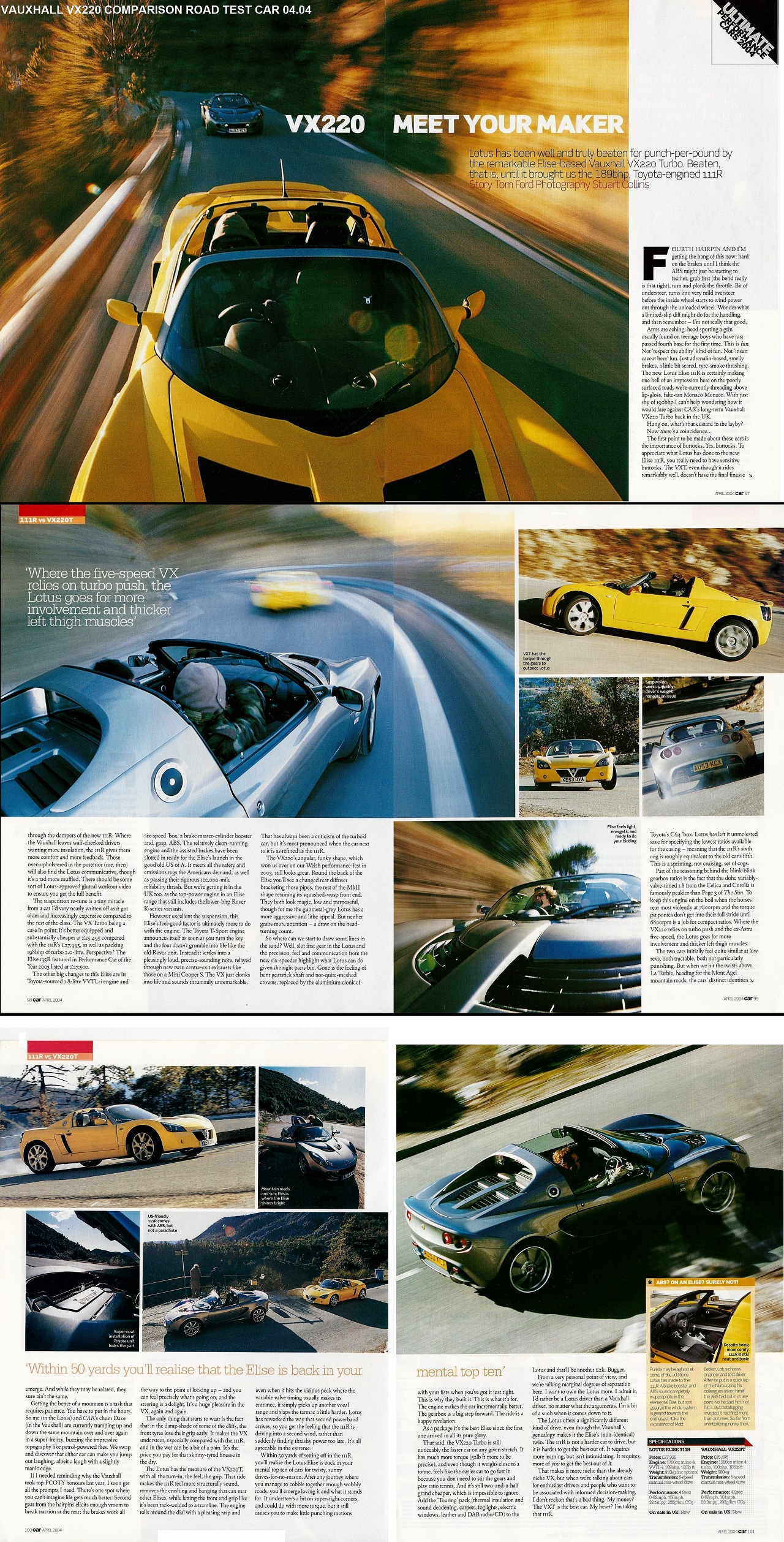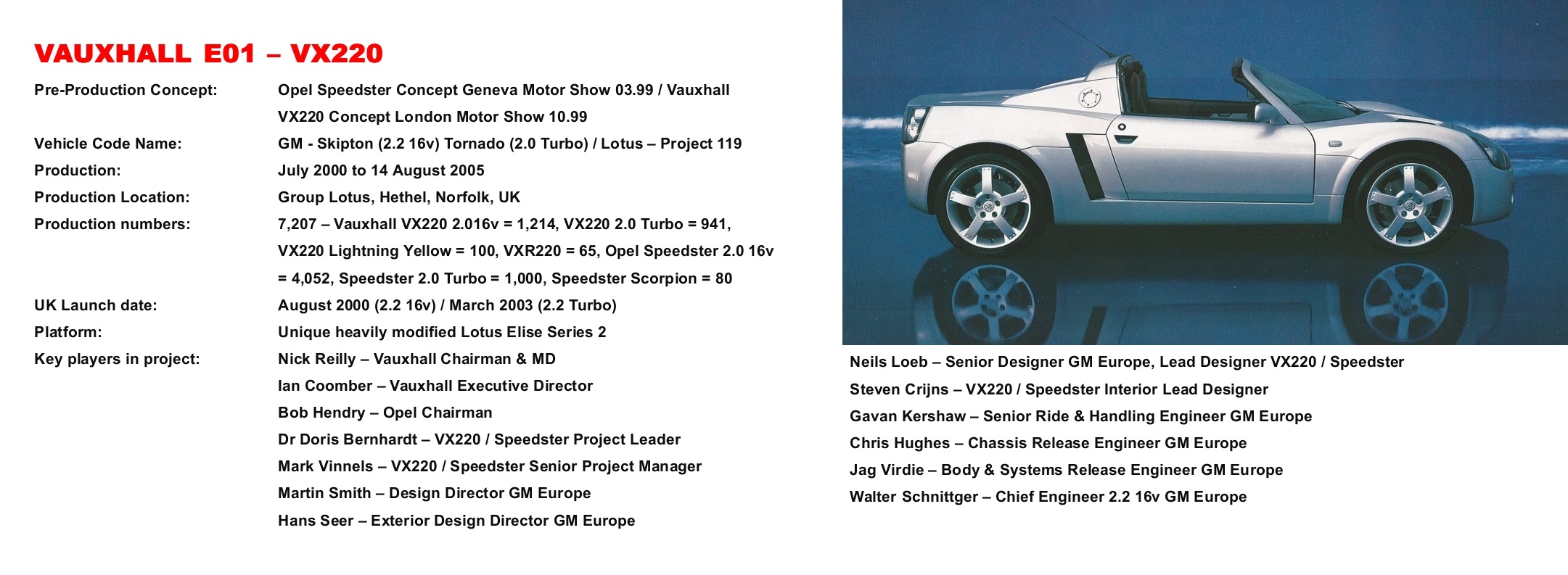


1. VAUXHALL E01 - VX220 BACKGROUND:
The Vauxhall sporting & performance heritage stretches back to the early part of the last century, during the Company’s earliest years a number of cars were entered into various trials and hill climbing events without any great success but in 1908 an experimental 2156cc X Type Vauxhall 12/16 was specifically built for the RAC 2,000mile & Scottish Trials. Later the same year, an uprated Y Type racing prototype based on the same car won the International Touring Car Trial – beating a Rolls Royce 40-50 in the process. Renowned cars such as the Prince Henry and 30/98 galvanised this sporting reputation until the near end of the 1920s. However, with the takeover by General Motors in November 1925, there followed decades filled with attractively styled, competently engineered and very popular cars aimed unashamedly at the family orientated motorist with little or no sporting pretentions implied or advertised. This trend unexpectedly changed in October 1961 with the launch of the Vauxhall VX4/90 variant of the Victor FB, with twin carburettors and an aluminium head its sporting pretentions were widely advertised, it was even successfully raced by the late, legendary, Bill Blydenstein for a few years. Behind the scenes, Vauxhalls Design Department were even working on a 2-seat roadster based on the Viva HA which unfortunately never saw the light of day. At the 1966 Geneva Motor Show Vauxhall stunned the motoring press & public with a display of a 2 seat, gull-winged, sports car concept – the XVR. Although one road-going prototype car was built the project went no further. In 1968 the VX4/90 had been dropped, temporarily as it happed, from the new Victor FD range but an even more overtly sporting model, the Vauxhall HB Viva GT, was launched with a 2litre OHC twin carburettor engine. The combination of this car with the immense talents of Bill Blydenstein & driver Gerry Marshall meant Vauxhall became a serious competitor in British saloon car racing. An FD VX4/90 returned to the range in October 1969 with the Viva GT engine under the bonnet. Vauxhall once again stunned observers in October 1970 by displaying the Wayne Cherry designed SRV concept at the London Motor Show, it looked about 30 years ahead of its time and made the new HC Viva on show look very tame indeed. In fact, for the next 2 years virtually everything Vauxhall did was “very tame indeed”, the VX4/90 continued into the FE range but it wasn’t until March 1972 that the unnecessarily dull HC Firenza finally showed signs of some sporting intentions with the launch of the 2300 Sport SL, by October 1973 all the OHC HC models were amalgamated into a new, sporty, Magnum range but that was not the end. Vauxhall also showed for the first time the stunning HP Firenza, a ground-breaking design by Wayne Cherry with a 5speed gearbox, 131bhp and an exceptionally low drag coefficient for the time, production cars didn’t get much more performance orientated than this. Alas, the fuel crisis, Britain’s dire economic situation & production issues meant only 204 were ever made but the impact the car made lasted for many years after. There was however one more Firenza / HC based concept built – the Silver Bullet prototype – used by Wayne Cherry himself, it used an experimental fuel injected 2.3 single cam engine, no less than 6 front headlights, a 5-speed gearbox and novel features such as a split folding rear seats as well as the HC Estate rear body, the car was not shown publicly but the front end certainly influenced Pontiac designers for their version of the upcoming FWD J Car in the US.
Vauxhalls track successes under the DTV banner with main driver Gerry Marshall were becoming prolific but, for reasons still unclear, Vauxhall changed tact to concentrate on the world of rallying and in the process another sporting legend was created – the Chevette HS 16v Twin Cam. In the hands of ace Finnish driver Pentti Arikkala and Brit Tony Pond the car achieved considerable rallying success. The road going car was equally impressive boasting a 2.3litre 16v twin cam engine giving 135bhp, a 5speed Getrag gearbox and body kit which left no doubt about what it was capable of. Along with the Lotus Sunbeam, these two cars were the FIRST “hot hatches” long before the VW Golf GTi tried to claim the same title years later. The Cavalier range, launched in 1975, included the sporty looking top of the range 1900 GL Coupe while the VX4/90 was dropped at the end of 1975 only to be resurrected for a short time in 1977 until July 1978, originally intended to include fuel injection and 150bhp on tap, it was only offered with a 116bhp TC engine with a 5-speed Getrag gearbox and a low ratio back axle giving sparkling acceleration for such a large middleweight car.
In October 1978, not content with the launch of his dynamic new Vauxhall Cavalier Sportshatch, Carlton & Royale designs, Wayne Cherry decided it was time for another WOW! moment. On display on the Vauxhall stand was a truly awesome looking, roadgoing 2 seat concept prototype – the Vauxhall Equus. This showed Cherry at his very best and again evidenced considerable forward thinking. It was designed in secret with a small team of designers, including John Taylor, and built by Panther who based the car on their Lima chassis which used the Vauxhall 2.3litre engine and running gear. When shown to Vauxhall management for approval to display the car at the upcoming motor show they simply said “show it, just show it”. But, it is to the detriment of Vauxhalls management at the time, of whom I have the greatest respect, that they didn’t opt to put the car into limited production with Panther, who would have been happy to build it in small numbers, a golden opportunity for a future classic lost. Wayne still owns the Equus at his home in the US.
By the late 1970s car designers were taking aerodynamic efficiency much more seriously and so to emphasis what was possible Wayne Cherry displayed his Chevette Black Magic concept at the October 1979 Motor Show to coincide with the latest developments for the 1980 model year production Chevette. The concept was based on an HS not HSR body-shell which was fitted with flush headlights, new bumpers & spoilers incorporating indicators and recessed fog lamps behind a grill below the front bumper, the side skirts were considerably lower than before and were finished with rubber which almost came into contact with the road surface, this gave a 20.42% reduction in drag compared to the standard car, front end lift reduced by 50.5% and rear by 37.3%. Another WOW! on an otherwise fairly moribund Vauxhall display for the 1980 model year, the Viceroy was the only new model on show.
This aerodynamic theme was taken to a whole new level in a new sports concept based on the Vauxhall Cavalier Sportshatch, called the Silver Aero, and first shown publicly at the October 1980 London Motor Show. Although the car was extensively modified it was proposed at the time to offer all the unique parts as a 3-phase kit that could be retro fitted by owners to any Cavalier Sportshatch unfortunately there is little evidence this actually happened, presumably because of the considerable costs involved. Phase I consisted of a completely revised interior with futuristic seating, door panels, lower dashboard and centre console. Phase II included aerodynamic glass fibre body panels front & rear as well the side and underside skirting of the body which reduced the drag co-efficient to 0.32cd. Phase 111 was an electronically controlled, stroked 2.4litre Turbocharged engine developed by Blydenstein Racing. The Vauxhall Design Department concept also included special full cover wheel trims which were used during aerodynamic testing.
In the last year of Vauxhall Astra MK1 production a new high performance version, the Astra GTE, waded into the hot hatch field with all the right credentials, the car was also the first car, in white, to use body colour wheels as standard. With a 115bhp 1.8litre fuel injection engine, 5-speed overdrive gearbox and Recaro seats it matched or beat anything in its class. The new J82 Vauxhall Cavalier of October 1981 was initially only offered with one remotely sporting model, the SR, but it used the same 1600 engine as the other models, soon a 5speed gearbox and a new “Sri” with fuel injected 1.8 or 2.0litre engine livened things up. Vauxhall broke new ground again with the launch of the Astra Mk2 GTE in 1984 which, with the best aerodynamics available, was capable of an amazing 127mph which left all competitors fumbling in its wake, a situation made worse with the later fitment of a 2litre 16v engine. Vauxhalls small car entry wasn’t left out either, the Nova GTE and later GSi models ensured Vauxhall were also very competitive in the “pocket rocket” segment of the market too.
Wayne Cherry was firmly established as head of design for the whole of GM Europe and the new Carlton Mk3 of 1987 was another example of inspired aerodynamic design with the GSi3000 offering imposing looks matched by equally impressive performance, especially the later 24v engine cars. As if 150mph wasn’t enough Cherry and his engineering associates proceeded, in conjunction with Lotus, to develop the biggest Wow! car of all, the most outrageous car ever to be offered by a volume car company up to that time, and for a long time since – the 177mph Lotus Carlton. With performance, so prodigious some countries, including the UK, tried to have it withdrawn from sale. It became a legend in automotive history and its impact when launched has never been equalled to this day.1988 and the Cavalier MK3 showed no let-up in performance developments with 16v, Turbo, 4-wheel drive and a 24v V6 being offered during the Cavalier production run, the car also marked the return of saloon car track racing success in the hands of the skilful Scott John Cleland.
The next shock that Wayne Cherry unleashed on the motoring world was the breathtakingly beautiful Vauxhall Calibra, just as most competitors were preparing to leave the coupe sector of the market Vauxhall revitalised it and dominated it for years to come, the basic version was also the most aerodynamic production car at the time. For a while the Calibra was also the cheapest 150mph new car available to buy in Britain.
The Vauxhall Astra Mk3 was not as radically styled as the Mk2 but was available at launch as a GSi with a 2.016v producing 150bhp. Replacing the Vauxhall Nova in 1993, the Corsa B was also available initially as a GSi with a 110bhp fuel injected 1.6 engine. In 1996 the Cavalier Mk3 gave way to the Vectra B which was offered as a GSi with a 2.5litre V6.
So by the late 1990s, Vauxhalls sporting credentials were beyond doubt however, the departure of Wayne Cherry from GM Europe Design to eventually become VP of GM Worldwide Design left a void that was inadequately filled by his temporary replacement Hans Seer. Fortunately, he was soon working under the guidance of the transient Martin Smith and crucially a new addition to the Design team, the supremely talented Australian born Niels Loeb, the GM International Technical Development Centre would now move in a new and much more dynamic direction.
2. VAUXHALL E01 - VX220 DESIGN & ENGINEERING:
When looking back at the situation General Motors found itself in during the latter part of the 1990s it is amazing the Vauxhall VX220 was ever built at all. In North America GM was already starting on a gradual death spiral that would, in the space of a decade, end up with a bankruptcy filling in 2009. In a complete reversal of custom & practice GM Europe had been starved of the normal unlimited funding in order to financially support the North American position. To make matters worse, 1999 would be the last year that GM Europe as a whole made a net profit. It is generally acknowledged that from 2000 to 2008 Vauxhall Motors Ltd either broke even or made a small profit but the figures were not officially separated from Opel within GM Europe.
In the list of key figures listed at the top there is one significant name missing, deliberately, GM Europe CEO Louis Hughes. Hughes was a member of an exclusive GM club, along with Alex Rhea, Roger B Smith, & J T Battenberg III – The Pratt Pack. Hughes mistakenly believed that to cut company costs the first place you start is with design & development, the VX220 project was to Hughes exactly the wrong sort of car that Vauxhall & Opel should be involved in and was the reason the development was so rapid, Hughes changed his mind about the car on an almost monthly basis.
Against this backdrop, all the other key people involved gave 110% to the project, frequently working unpaid in the evenings and at weekends such was their enthusiasm. They fully appreciated the benefits that a striking 2 seat true sports car could bring to Vauxhall & Opel as a halo product for the rest of the range. So, did GMs European Brand Team, they had seen the effect the Calibra and Vauxhalls racing success with the Cavalier had on the Vauxhall brand. Ian Coomber had played a significant role in the resurgence of Vauxhalls image, this and the fact that Britain was expected to be the biggest single market for the new sports car meant he was included in the project from the start and even gave the project its code name – Skipton – and the eventual model name – VX220.
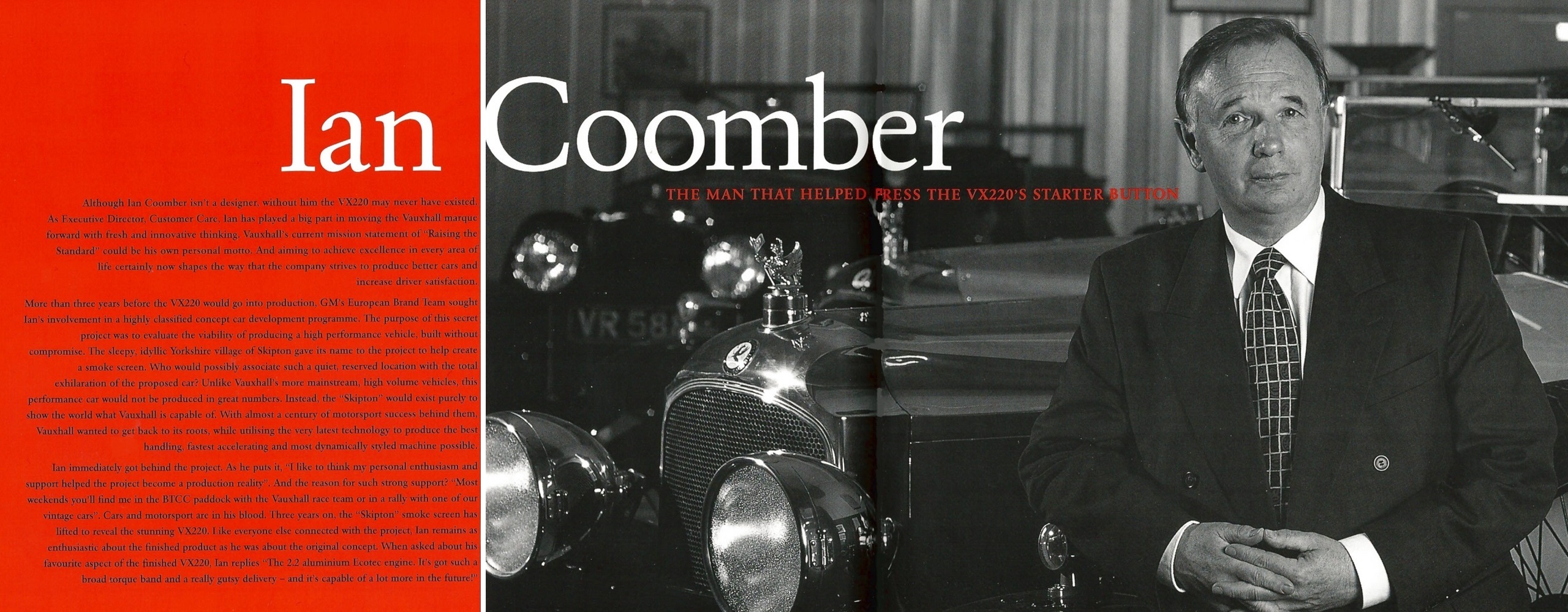
The Project Leader for Skipton was Dr Doris Bernhardt, although experienced at the GM ITDC her new role was more challenging because of the narrow focus of the car and what would end up being a multinational production operation. Any development costs needed to be kept in check and left no room for the myriad of different designs and experimental prototypes normally involved in a new model development. For a start the total number of people directly involved was a fraction of the normal allocation, with each totally focussed on their own area of expertise. The overall budget for design & development was extremely limited and the first major challenge was how, and where, to build it. Neither Vauxhall in Britain or Opel in Europe had the ability in any of their plants to build such a specialist car that was being proposed. Opel had close links to bespoke builder Bitter but they made it clear they were not interested in such a project. In the UK Lotus had a problem, nothing unusual, their Elise Series 1 would be unfit for sale after 2000 because of new impending safety legislation. Financially, Lotus did not have the ability to re-engineer the Elise on their own and were actively looking for a partner to share the costs. General Motors wholly owned Lotus earlier in the decade and, even after selling the company, they still extensively used their well-known suspension engineering skills. The Skipton project was the perfect match for both Lotus and Vauxhall-Opel, both cars would meet all crash regulations outside of North America. Lotus successfully submitted a tender to undertake the co-development, prototype construction and series production of 7000 cars over 3 years at their Hethel factory, which would be expanded for the purpose.
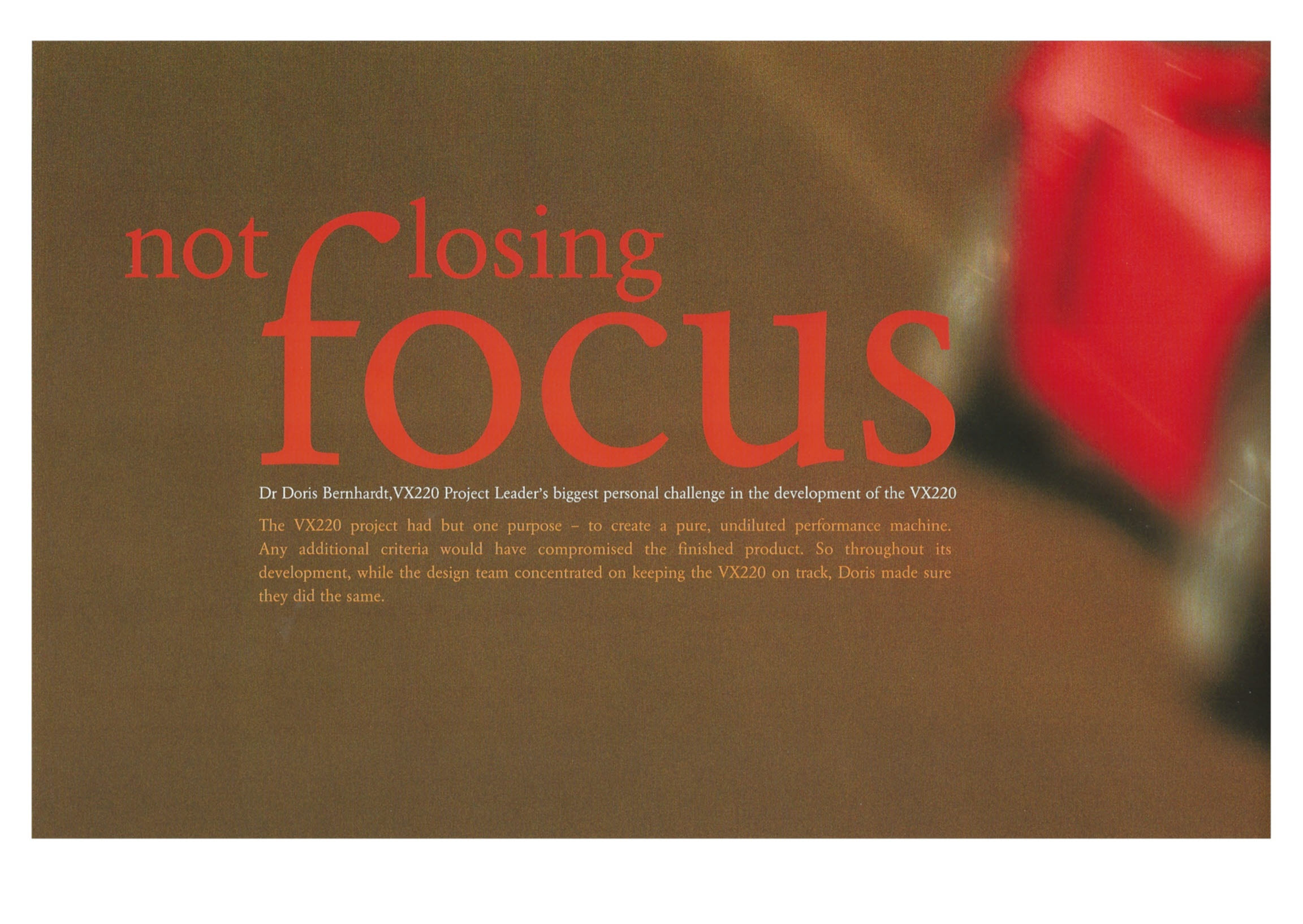
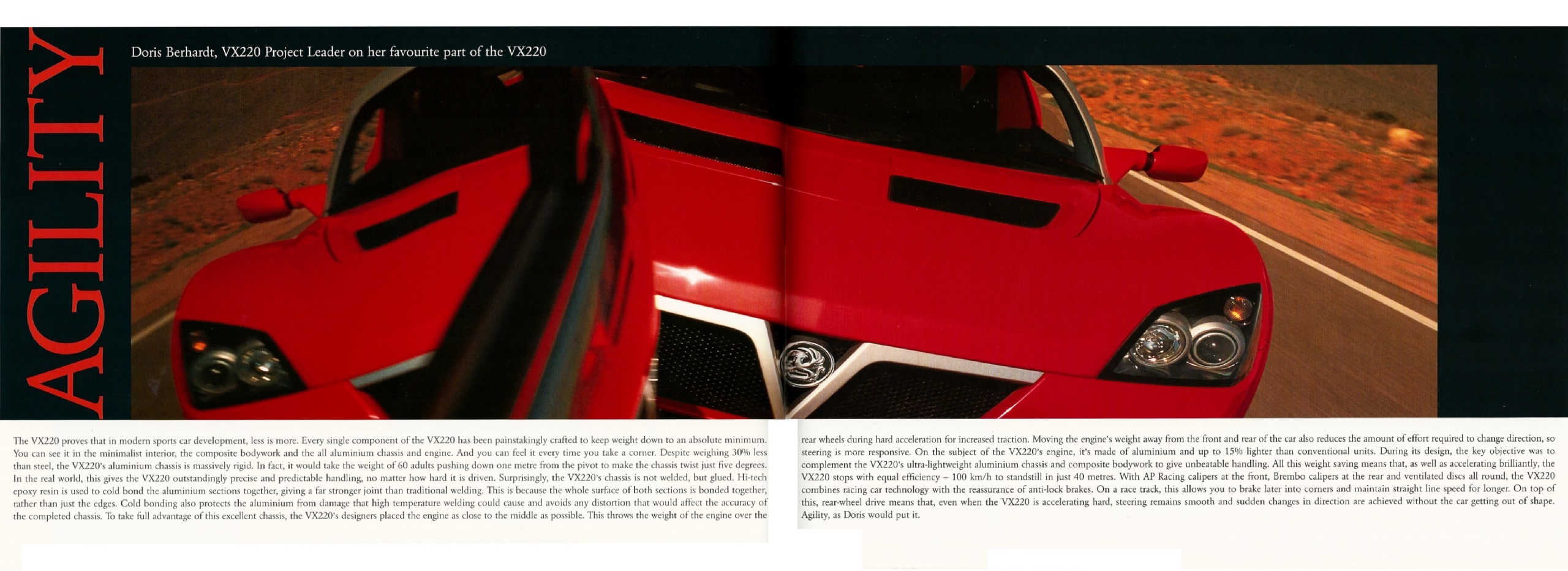
In anticipation for the new sports car initial design sketches were started in late April 1998. The concept & styling of the VX220 would put Vauxhall, and Opel, in the spotlight as car manufacturers that would no longer be considered merely as makers of mass-market family cars. Their role was to begin a transformation of the public image of both companies, particularly that of Opel. That was the view of Niels Loeb, the talented Australian-born Assistant Chief of Design at GM Europe, who was responsible for most of the VX220 exterior, while Steven Crijns created its wild interior. Guided by Martin Smith, Lobe drew on the company's latest design DNA, and projected it further forward in a more radical, in-your-face, fashion. Speaking about the origins of the idea at the time, Lobe explained: "We first asked the question, what is Vauxhall & Opel today? We than asked ourselves, what will Vauxhall & Opel be in the next century?
"The main conclusion was that we were not regarded as aspirational brands, particularly Opel in Germany, so we're setting out to put that right and win over more youthful customers." The need for more convincing actions in repositioning the brand was an obvious starting point. But, according to Niels Loeb, there was also the incentive of Opel celebrating its centenary of production in 1999, the approach of the new millennium and Vauxhall’s own centenary in 2003. Penning the VX220 should have been a designer's dream, but, according to Niels Lobe, it became a headache. Time was at a premium, the project was officially initiated in July 1998 and the first full-scale model was displayed to senior Vauxhall & Opel Executives in October when the decision was made to proceed. Loeb explained: 'There was not the normal time for the project, as a second, production specification, concept needed to be ready for the Geneva Motor Show in March 1999. This was made slightly easier as all the body panels were made from glass reinforced plastic, something which Lotus had plenty of experience with and were responsible for building both of the first two display prototypes at their new Body Engineering Centre, near Coventry.
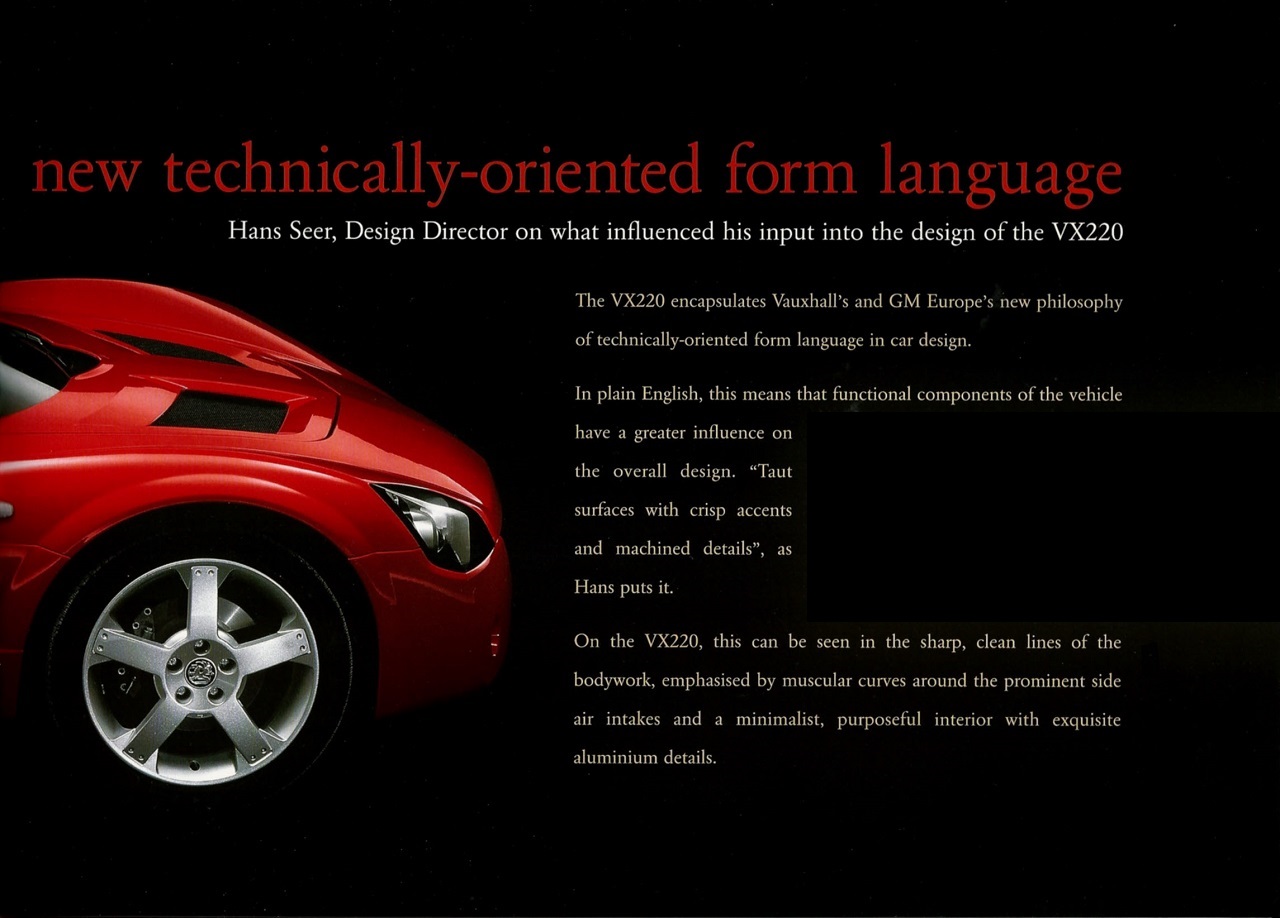
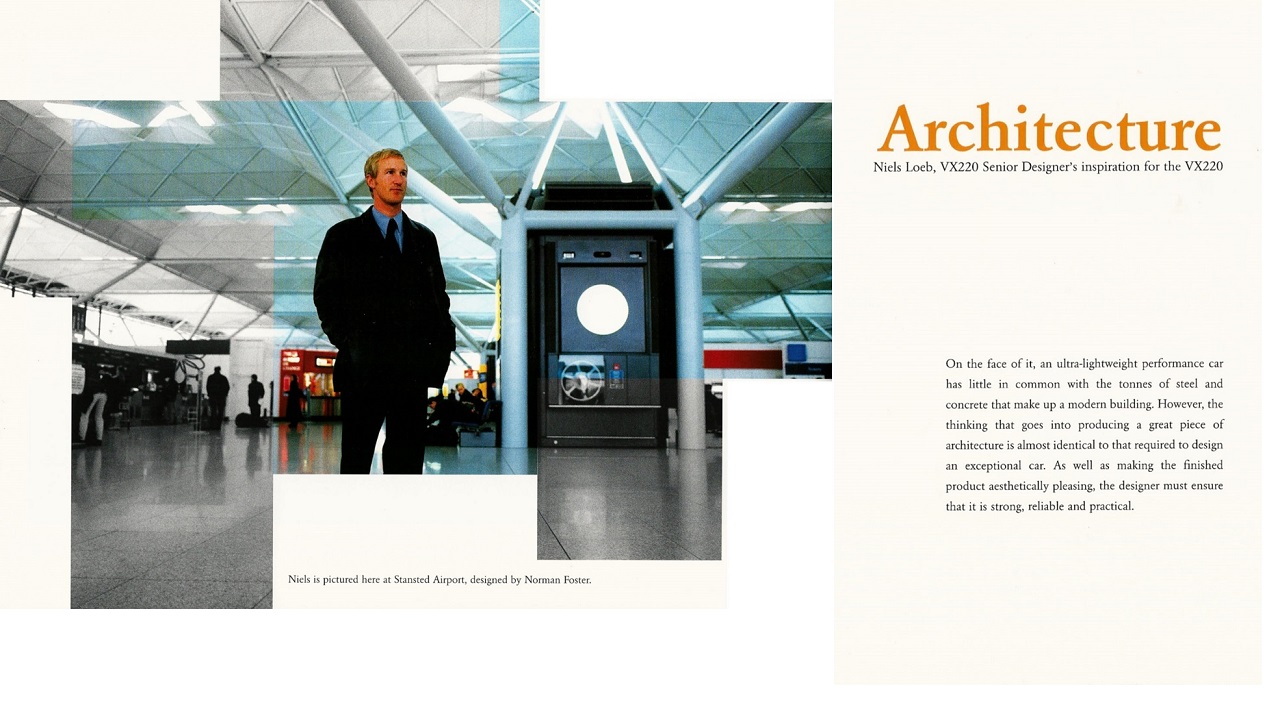
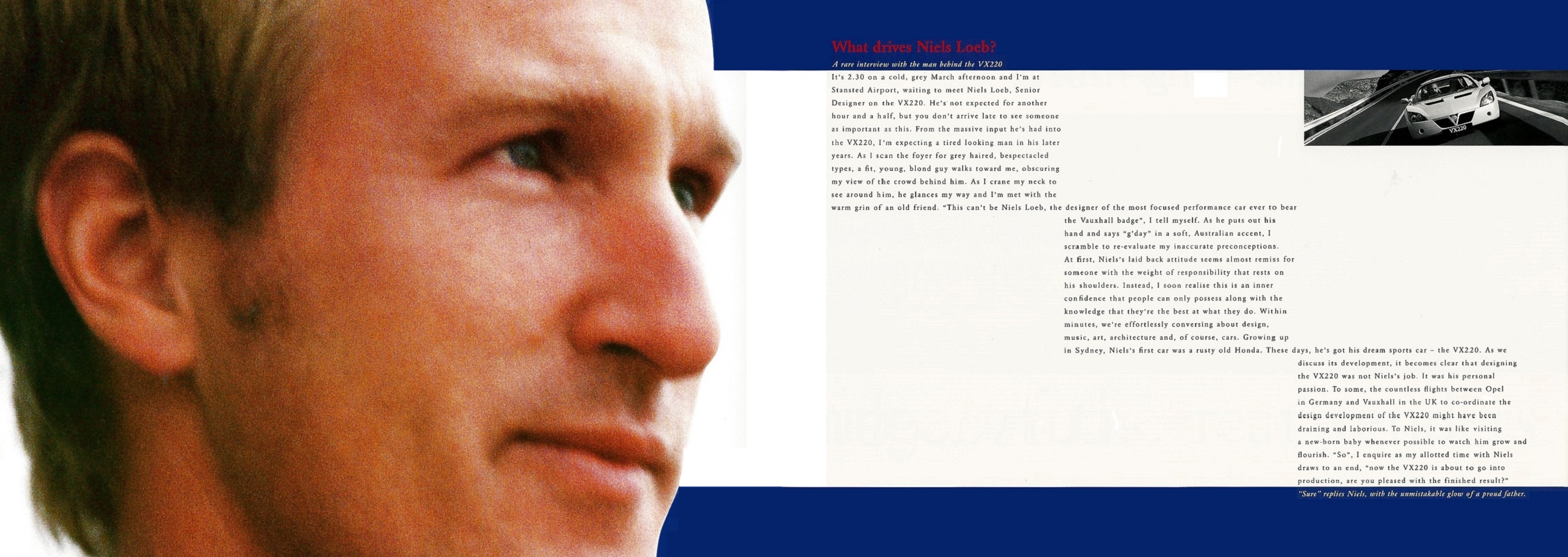

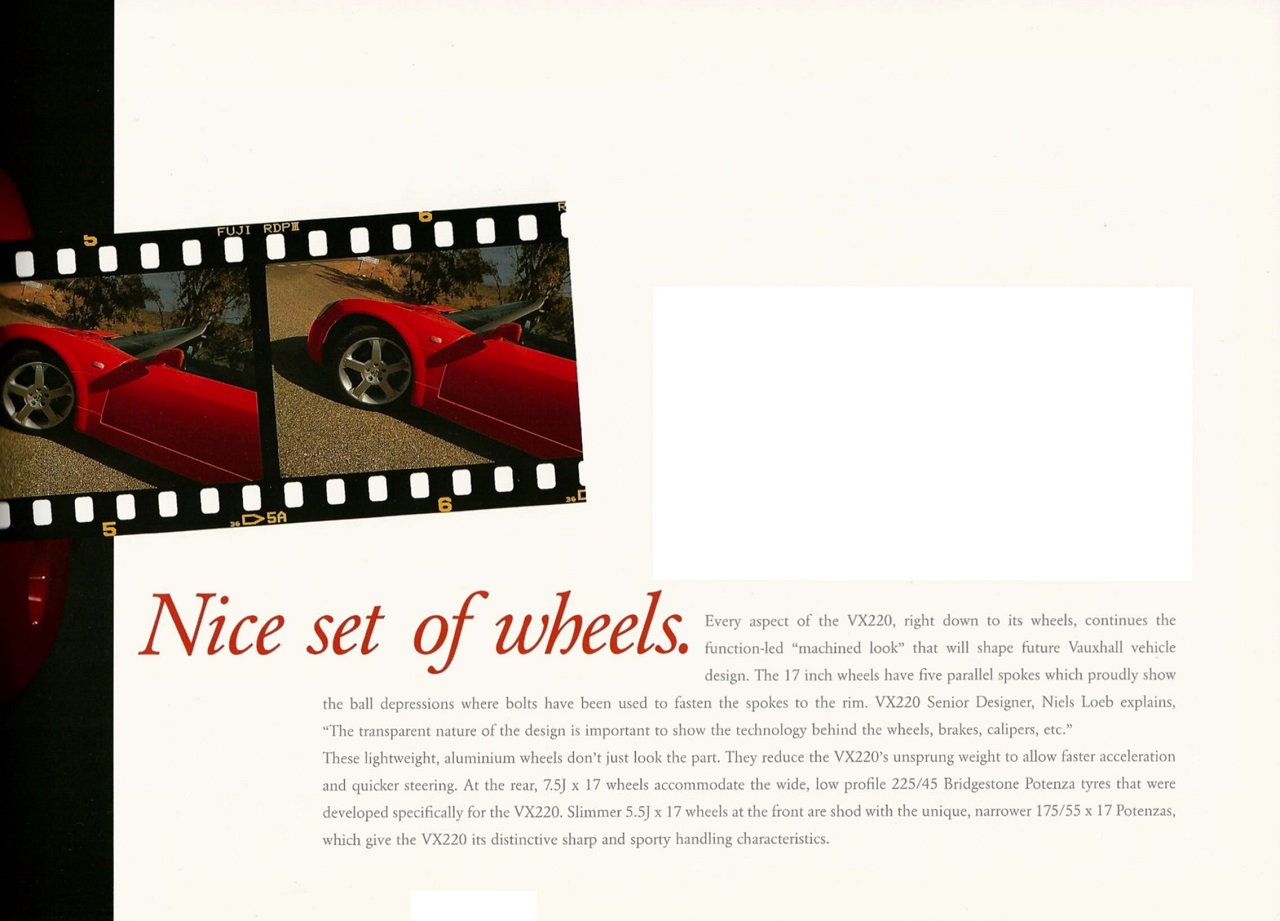
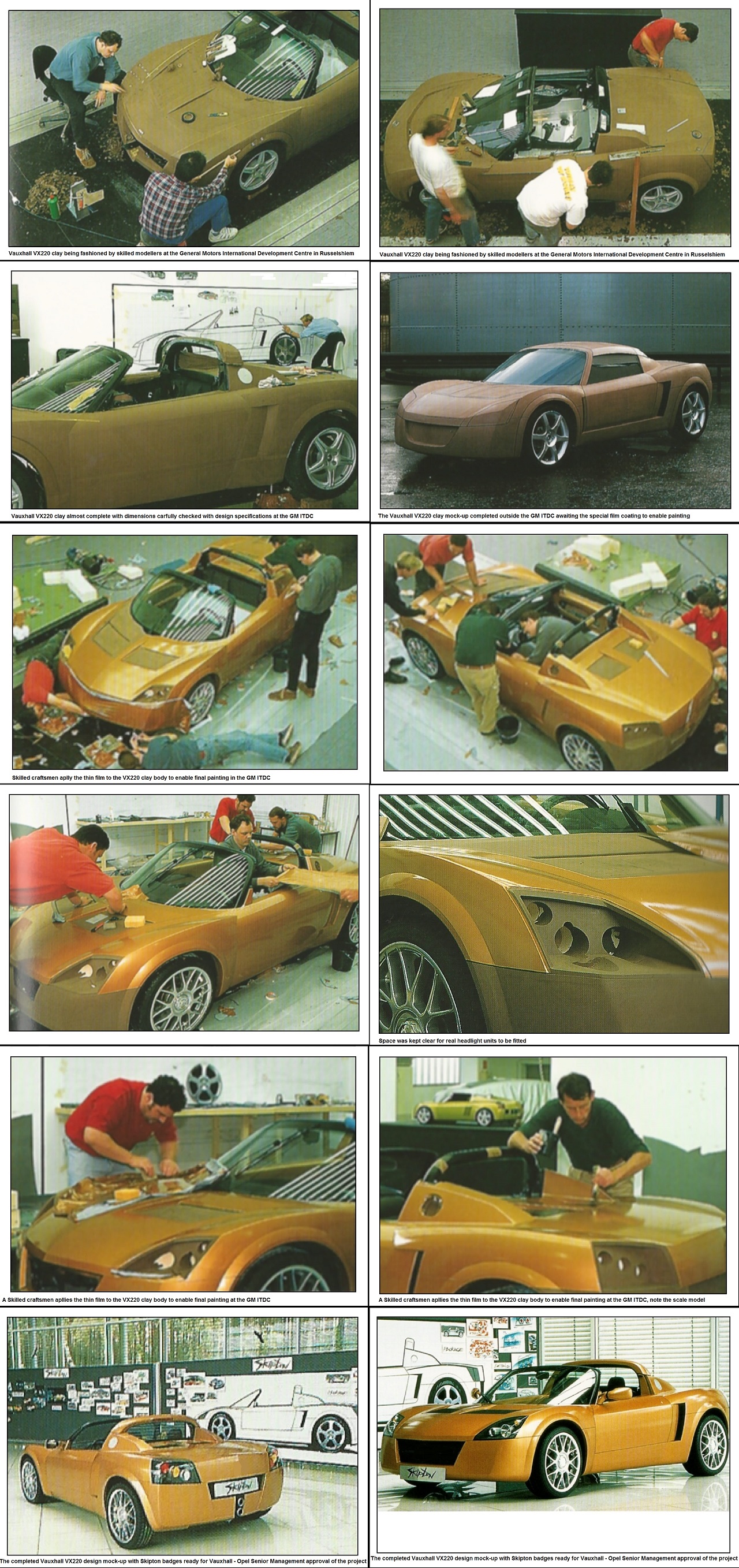
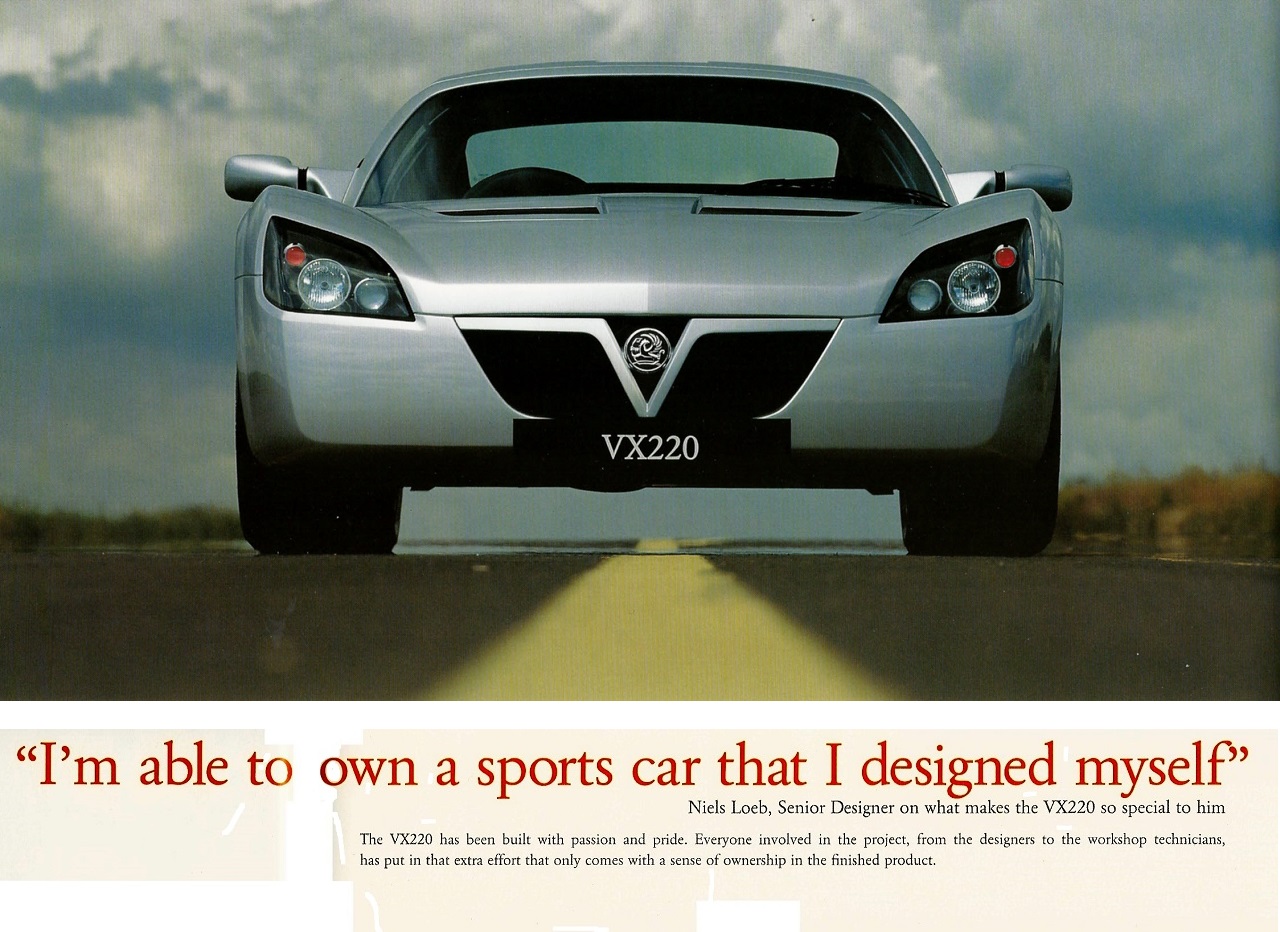
Contrary to claims at the time, the new all aluminium 2198cc Z22SE engine was not designed specifically for the VX220 and it was not designed by Lotus either. The ECOTEC engine was a DOHC 16v design with an aluminum block and head, designed for displacements from 1.8 to 2.4litres. Development had started in 1994 by an international team of engineers and technicians from the GM ITDC, GM Powertrain in Pontiac Michigan and Saab and in Sweden. Much of the final development work on this project was carried out by Lotus Engineering, Hethel, UK. The engine used aluminium pistons and cast iron cylinder liners. Vibration is reduced with twin balancer shafts. In Z22SE form it first appeared in the VX220 & Saturn LS1 in 2000. In the USA, it was tagged L61 and LK9 by Saab. The installation in the VX220 did require modified inlet & exhaust manifolds as well as unique air intake system to suit the mid-engine configuration.
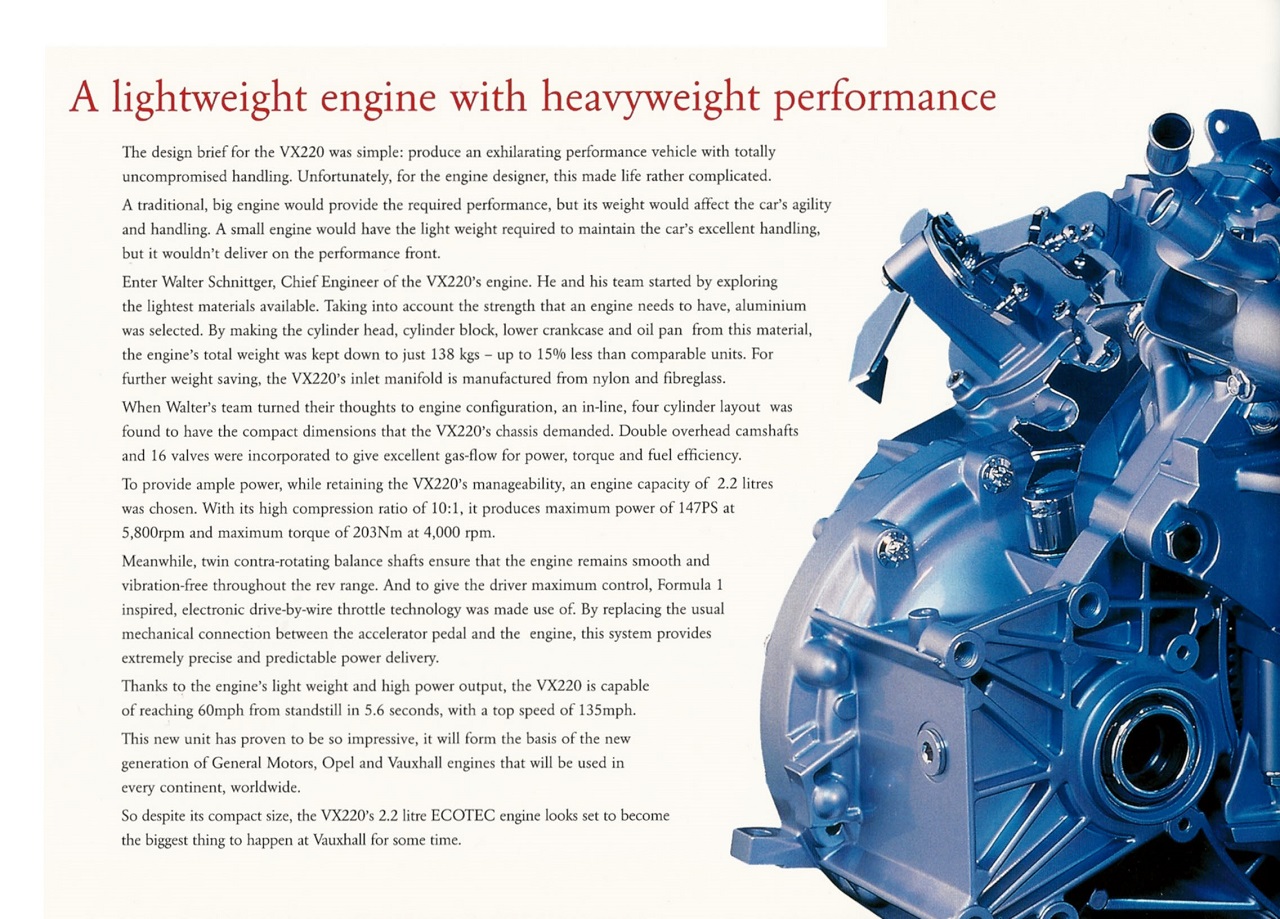
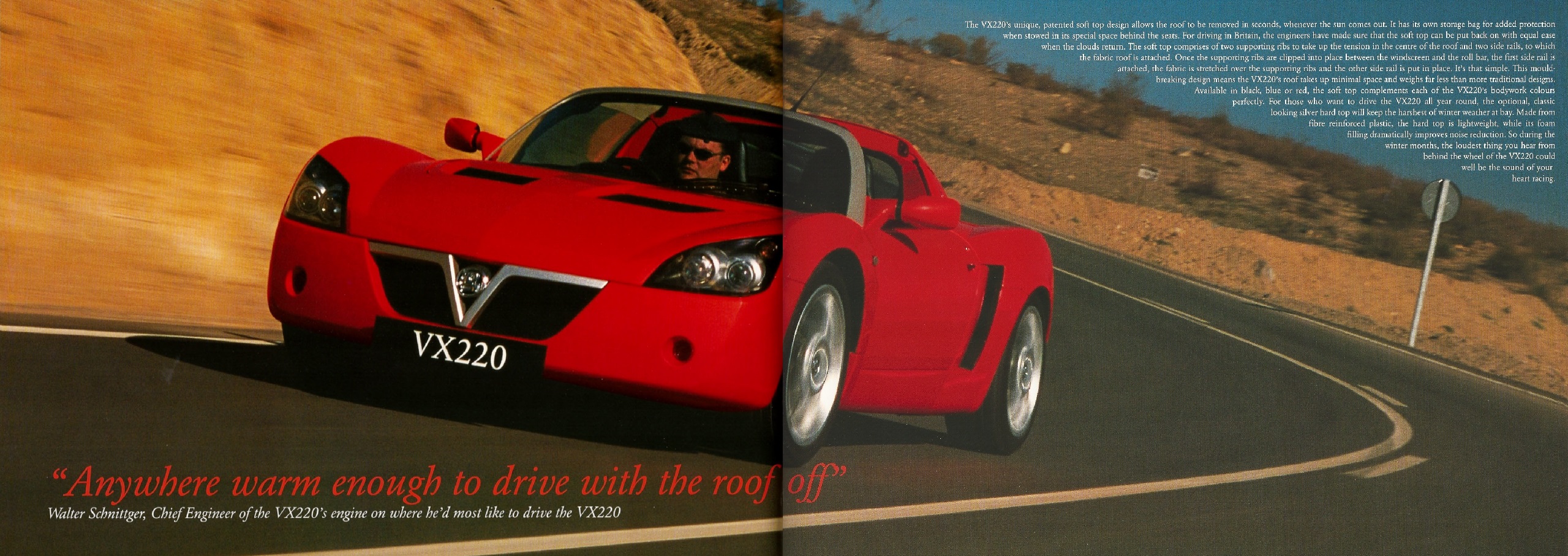
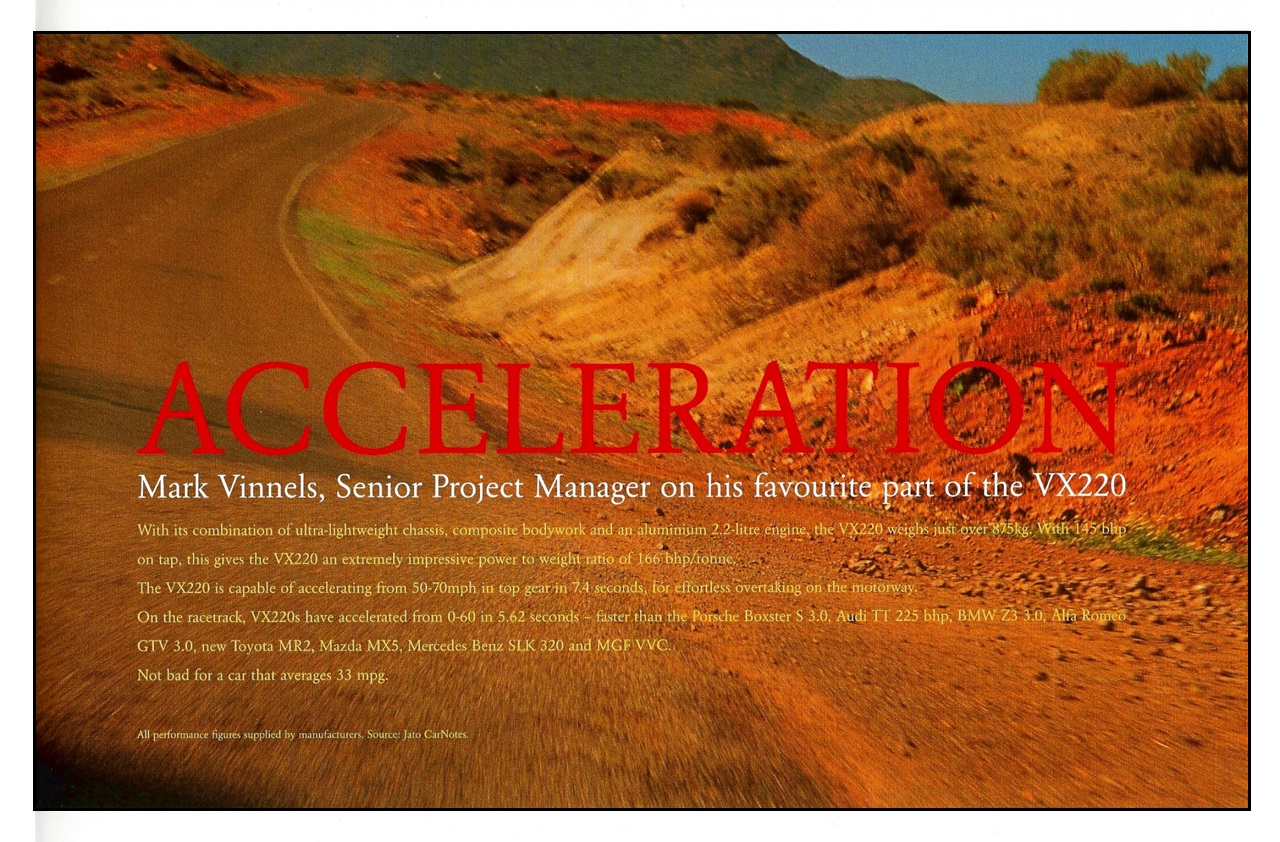
Steven Crijns interior design was, on the face of it, minimalist in the extreme with some parts of the exposed aluminium chassis components being integrated into the design. Only the essentials were included plus driver airbag, ABS & centre dash mounted start button with leather seat trim being an option. Hidden from view were the side impact bars.
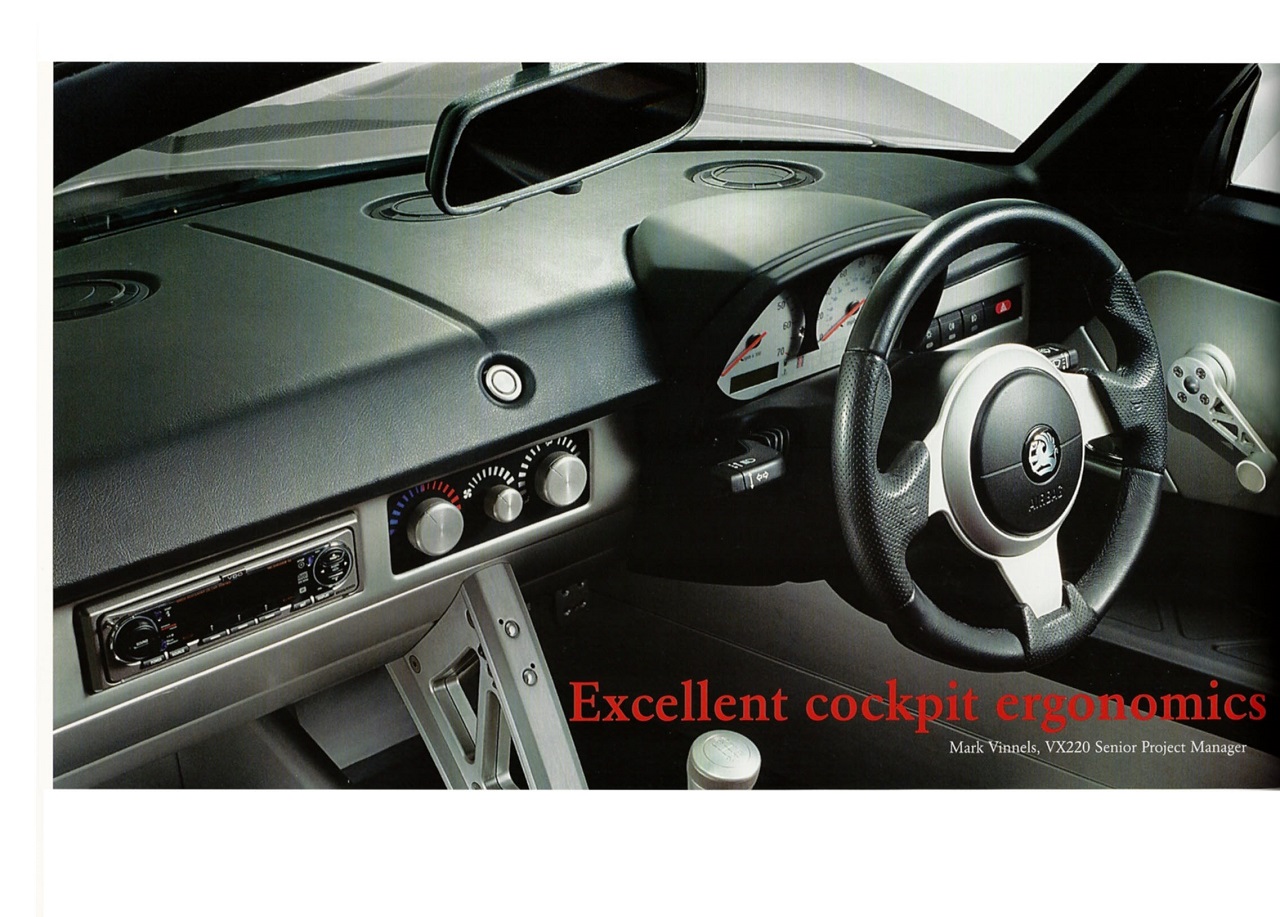
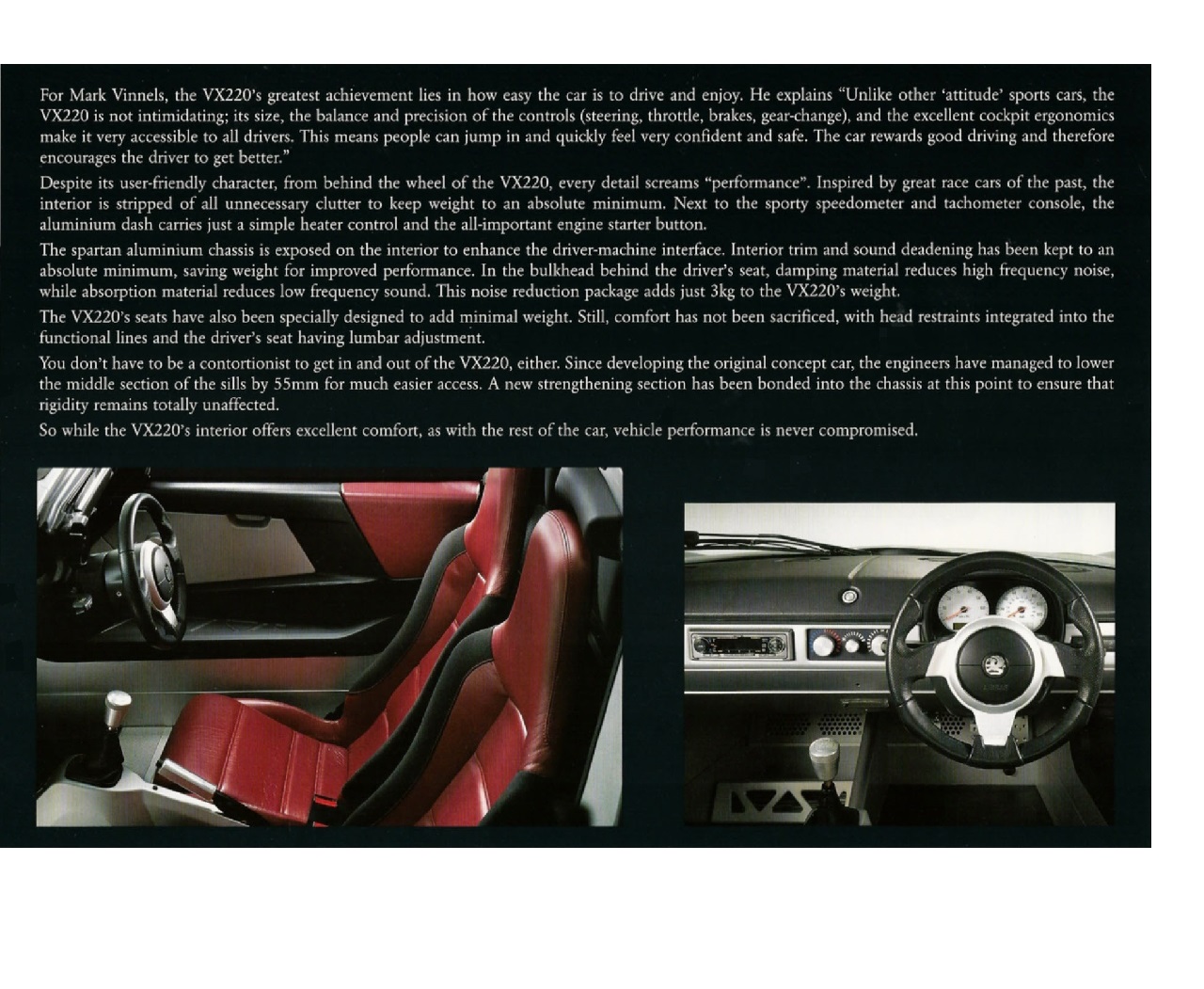
The VX220 aluminium chassis was similar in size & shape to the Elise and was bonded, not welded, together and supplied by Hydro Aluminium Automotive Structures - the Birmingham-based company responsible for the supply of the Lotus Elise chassis. If development had been left to Lotus alone the VX220 would have been a more challenging car to drive but GM wanted to ensure that the car would be forgiving enough for an “average” driver not to get into difficulties, the result was a slightly diluted drive compared to an Elise. Lotus also wanted to fit smaller 16inch front wheels with 17inch rears, Vauxhall overruled this and opted for 17ins wheels all round based on better aesthetics – 7.5J X 17 with low profile 225/45 Bridgestone Potenza tyres specially developed for the VX220, at the front narrower 5.5J X 17 with 175/55 Potenzas. Most of the initial chassis calibration was carried out by Lotus Engineers with further refinements dealt with by the ITDC staff.
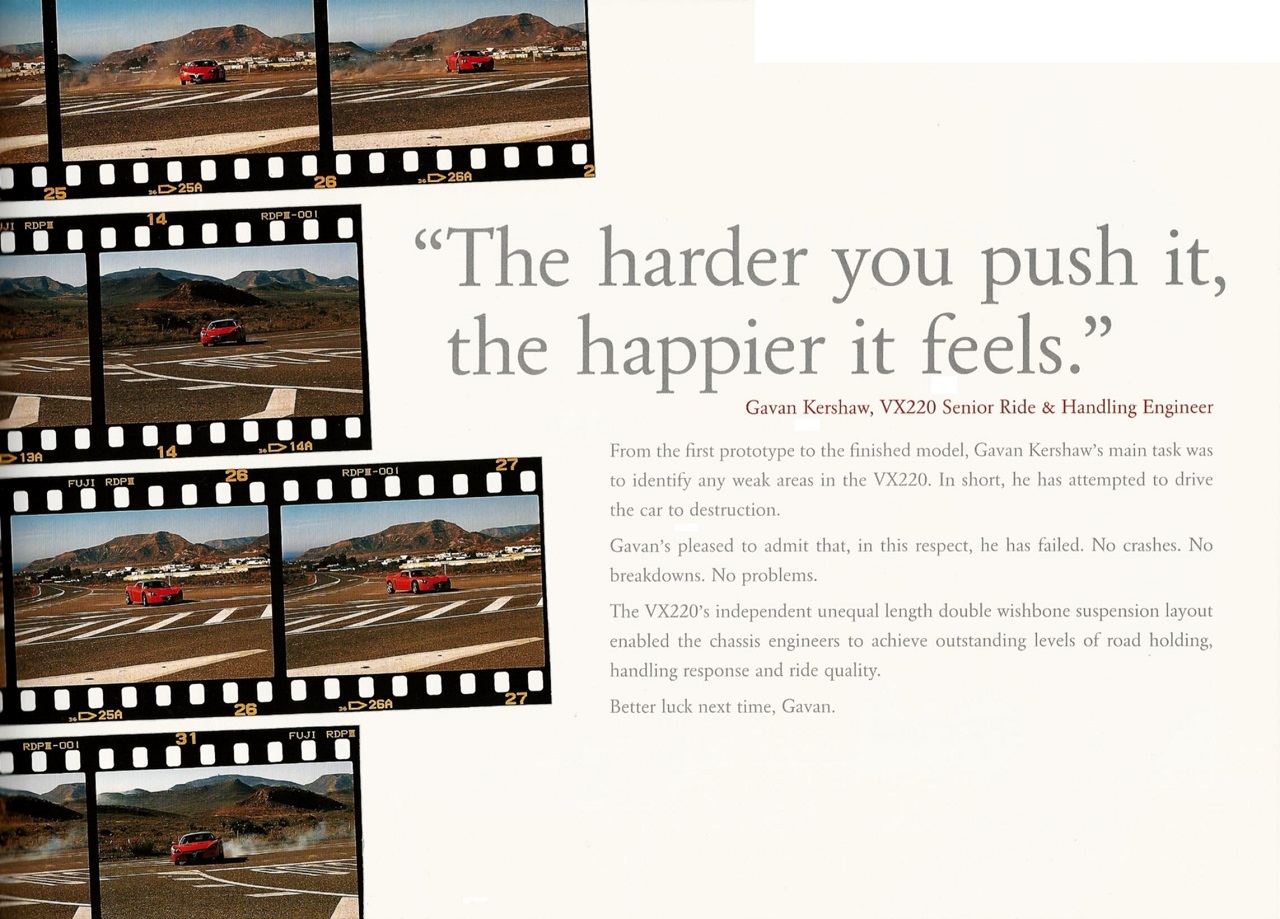
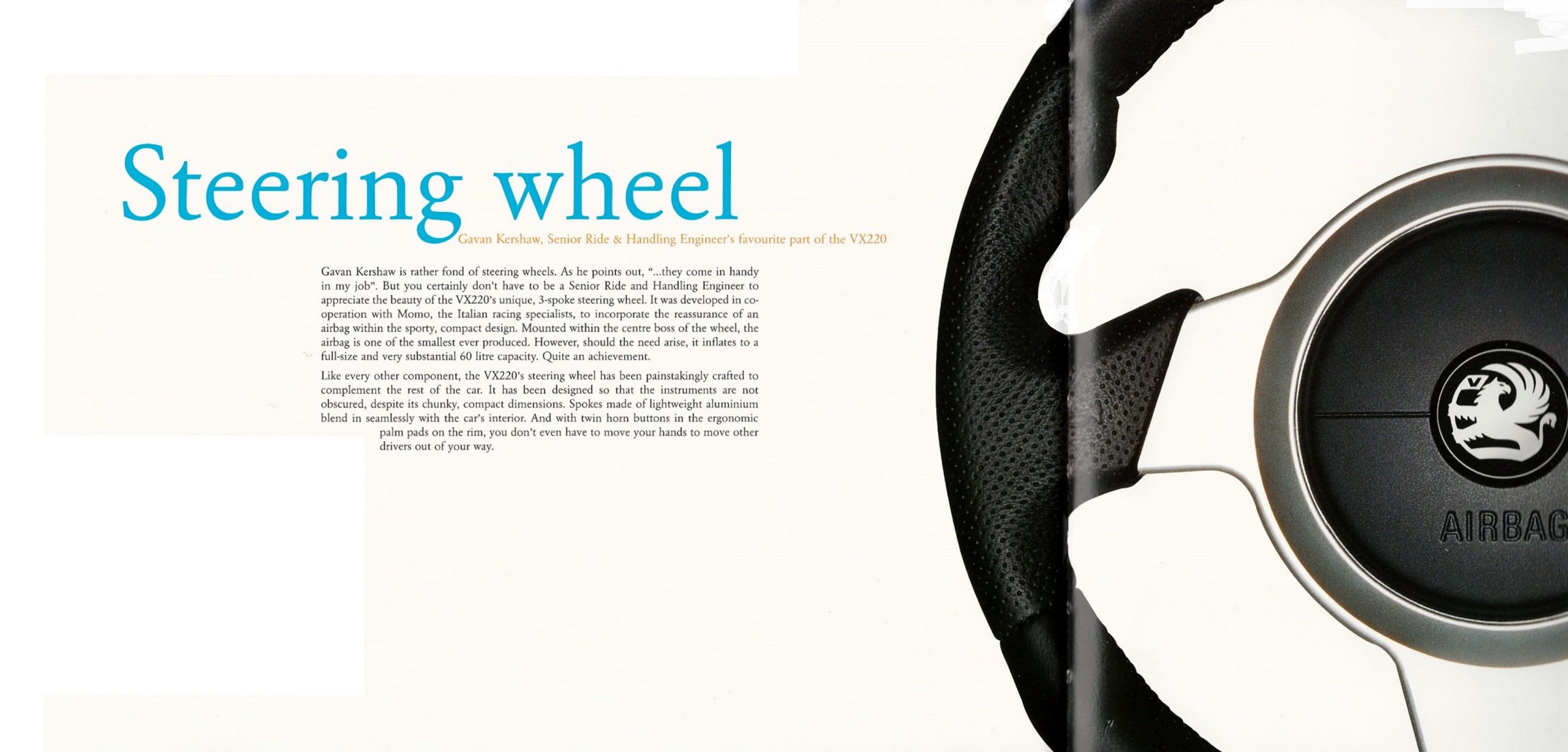
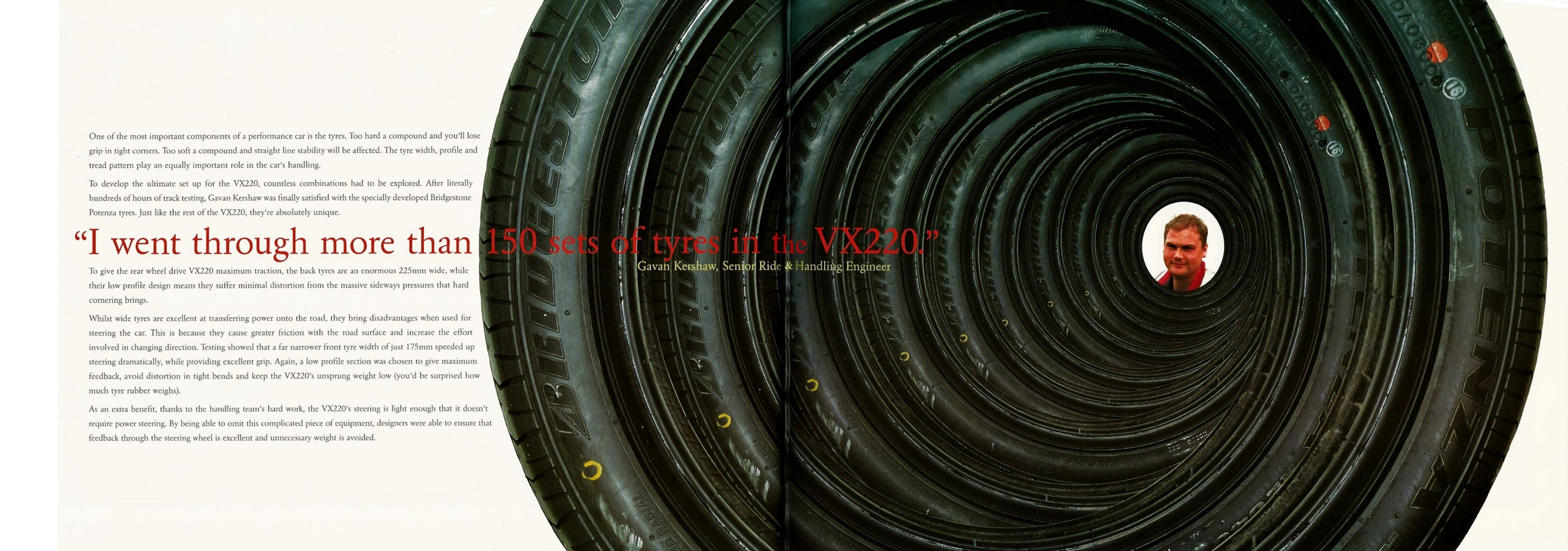
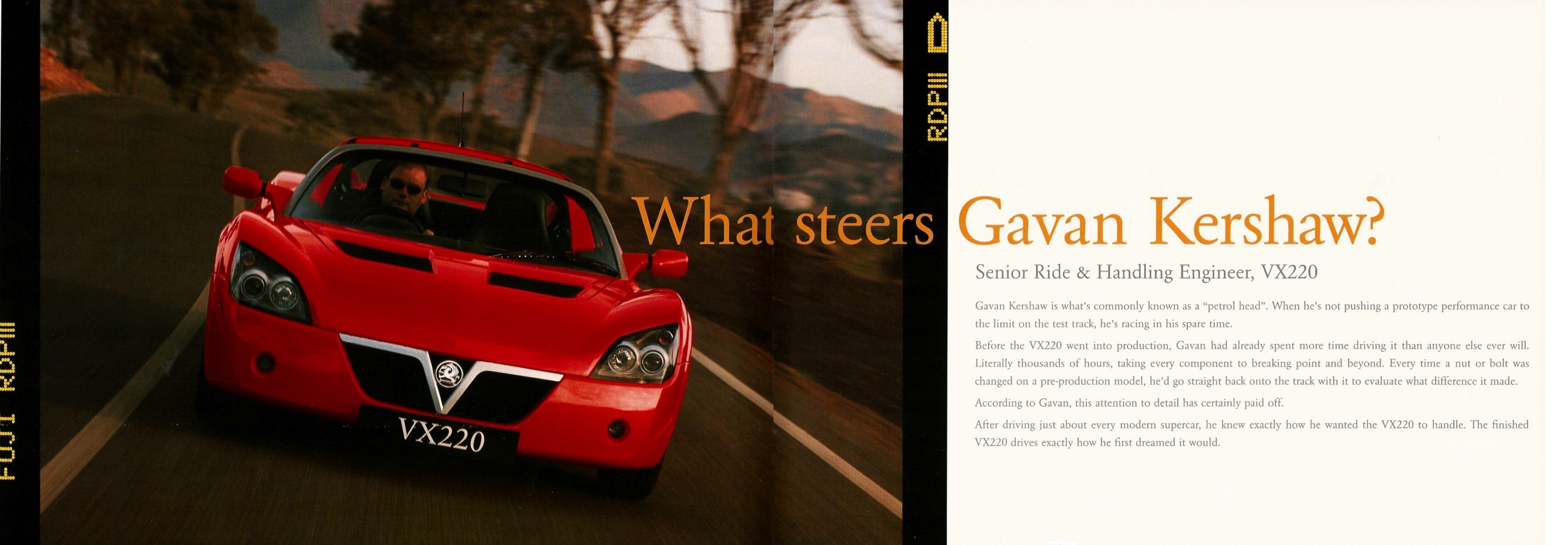
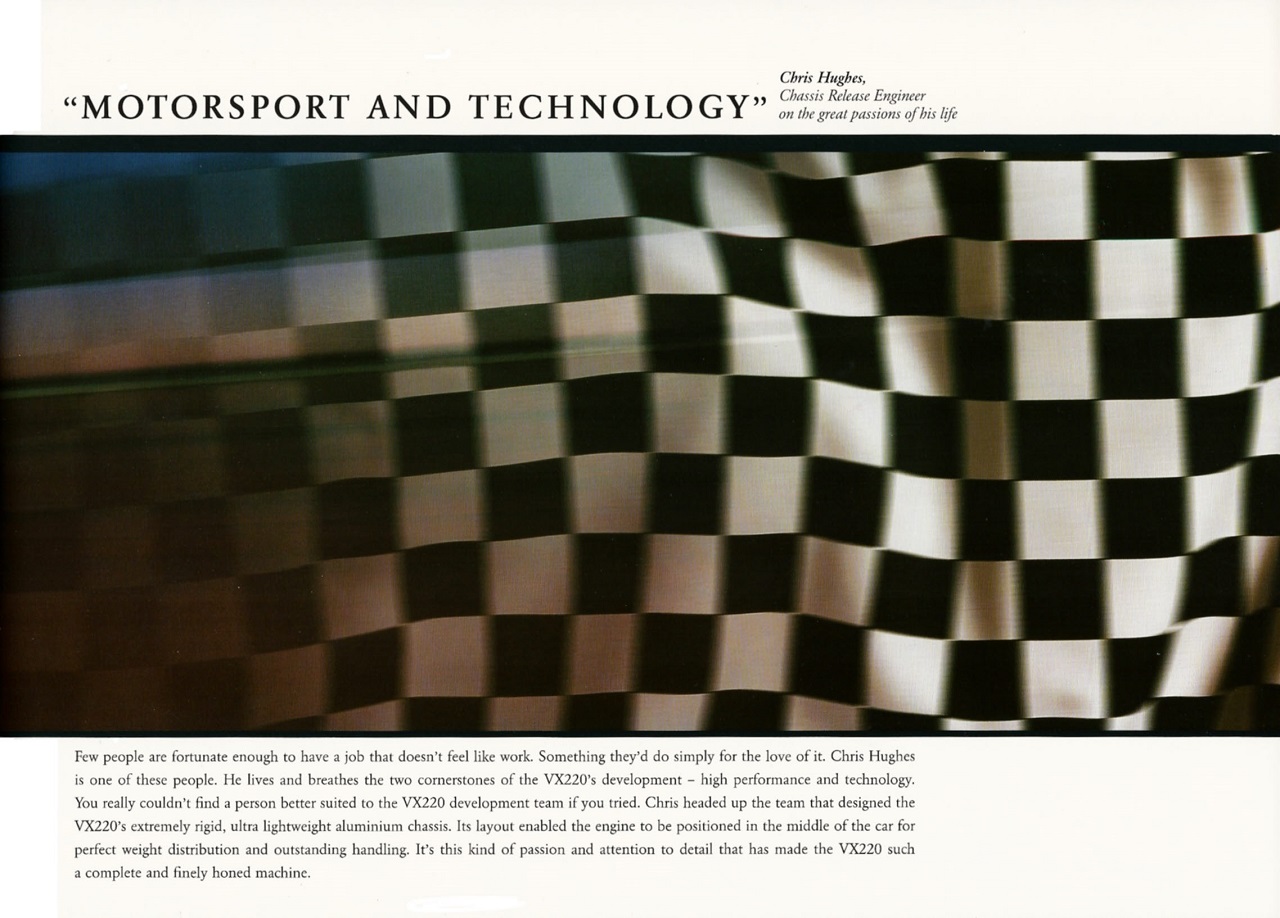
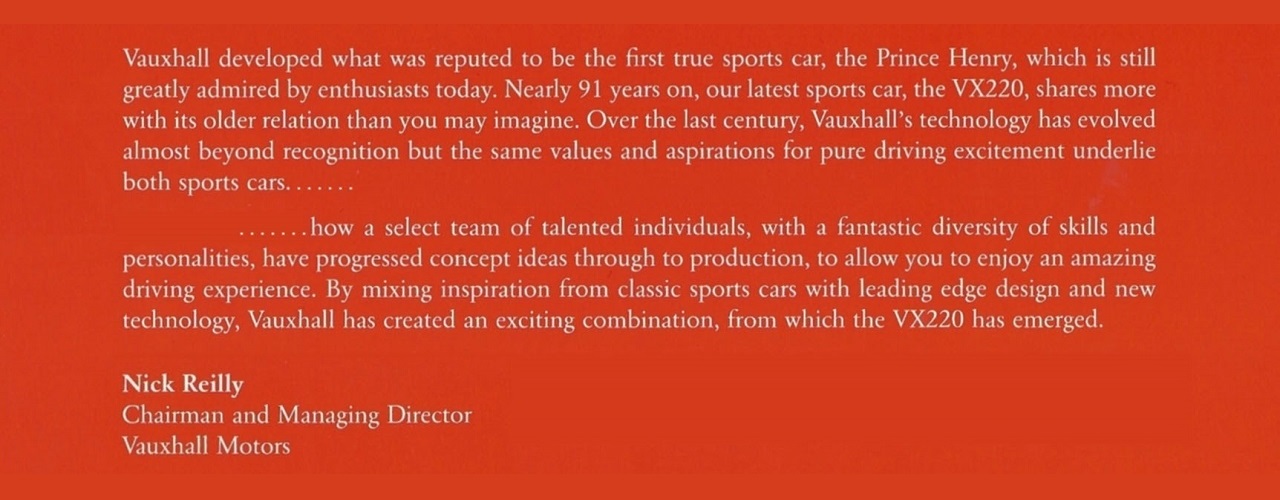
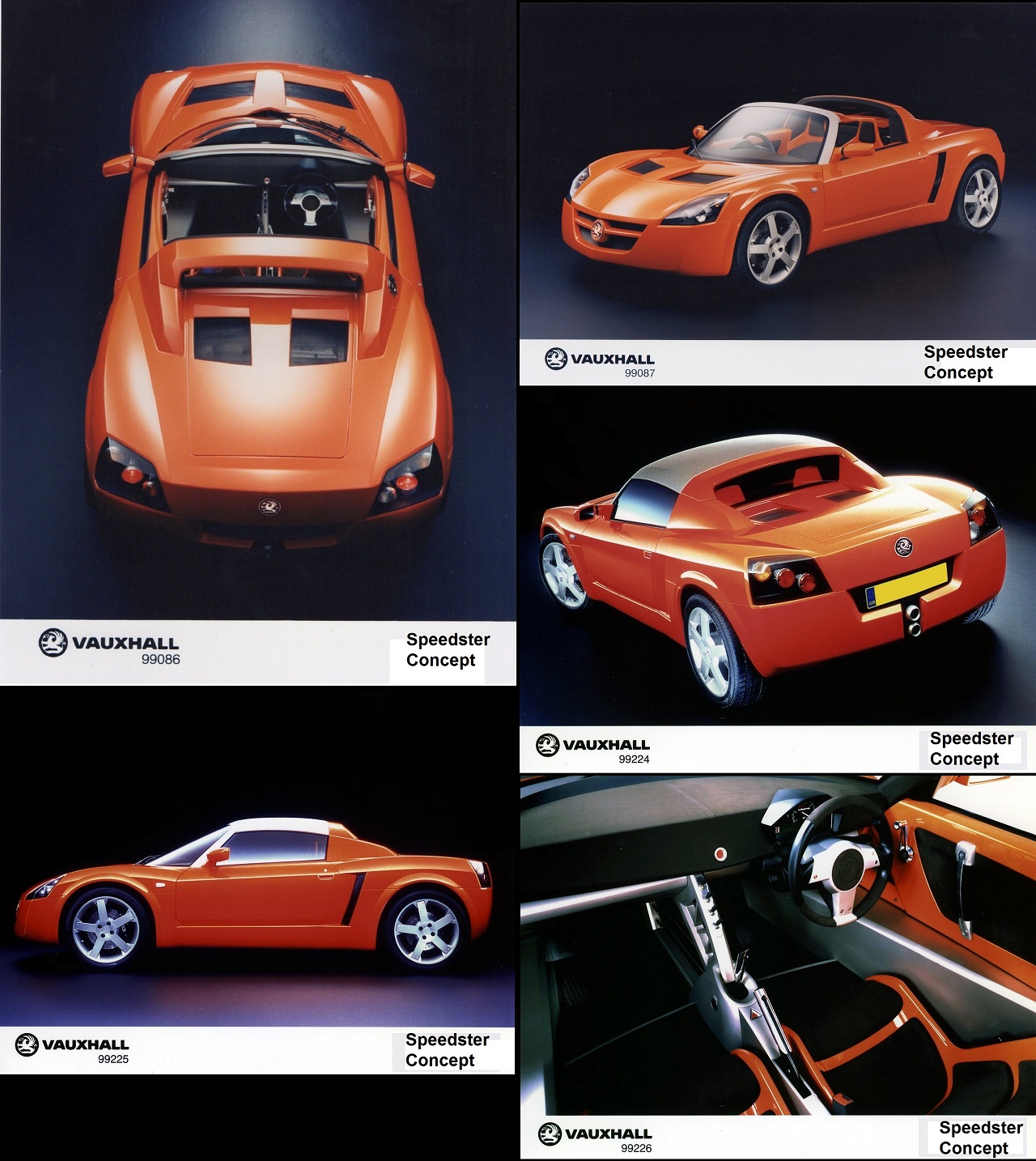
In September 2002, a new prototype based on a variation of the Vauxhall VX220 platform was announced – the ECO Diesel Concept. The performance of the very compact engine in the new engineering study was particularly impressive. The displacement of the all-new ECOTEC-CDTI diesel, with the latest-generation multi-jet common rail fuel injection, four valves per cylinder and variable-geometry turbocharger, was only 1.3litre. The 4-cylinder engine was the first all-new power unit developed by the GM-FIAT Powertrain joint venture, made its production-debut in 2003 and met the forthcoming Euro 4 emission limits. In the Eco-Diesel Concept, it was mated to Vauxhall’s Easytronic automated manual transmission. The aerodynamically optimized and lightweight Eco-Diesel, with its swooping, long-tail bodywork, demonstrates impressively the performance potential of the future 1.3-liter ECOTEC CDTI engine. During initial testing the 112bhp concept car reached a maximum speed of more than 155mph while fuel consumption in the MVEG cycle was a miserly 2.5liters per 100 km. The prototype was based on the mid-engine VX220, but featured new, carbon fibre bodywork with much improved aerodynamics. With significantly reduced drag (Cd = 0.20 vs 0.38) and even lower weight (around 660 kg
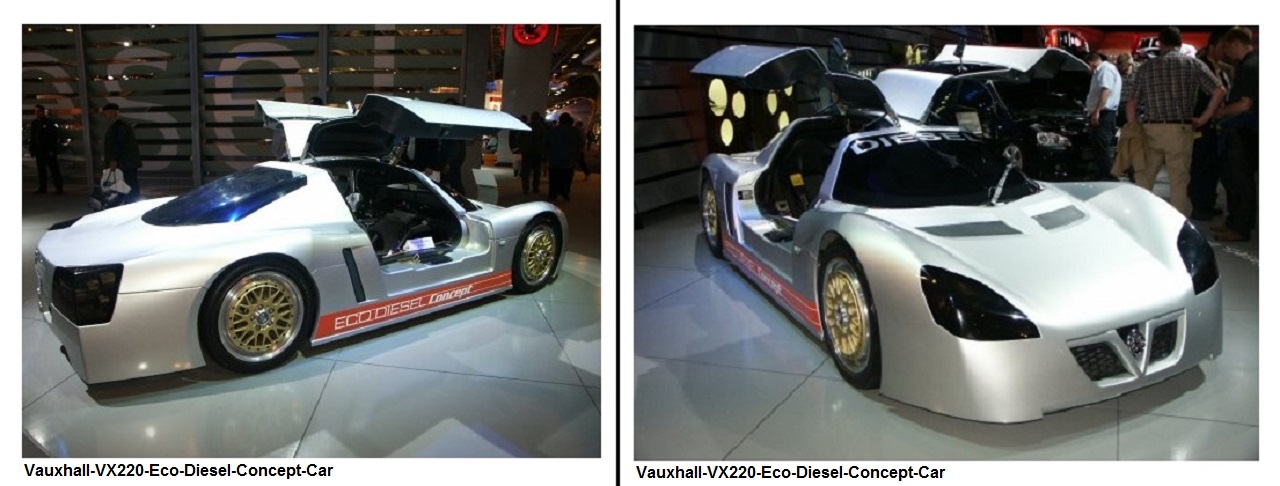
The Vauxhall VX220 & Opel Speedster were sold all European markets and there were plans for selling the car in Australia & New Zealand as a Holden. One car was shipped for evaluation but Holden’s testing programme at their Lang Lang Proving Ground highlighted that the car would require extensive modifications to cope with all Australian conditions. In South Korea GM Daewoo exhibited one Speedster Turbo with appropriate Daewoo badges at the Seoul Motor Show but nothing was ever seen of it again. The initial planned deliveries to VX220 customers was delayed until August 2000 and although, as predicted, the UK was the largest single market for the car the plan of 7,000 units in 3 years wasn’t achieved, it took nearly 5. A Turbo version was introduced to stimulate sales using the 2.0 Z20LET, this took the performance into established supercar territory, but sales were still below expectations. Today the car is an established classic, fully justified, and has a loyal owner following and owners clubs.
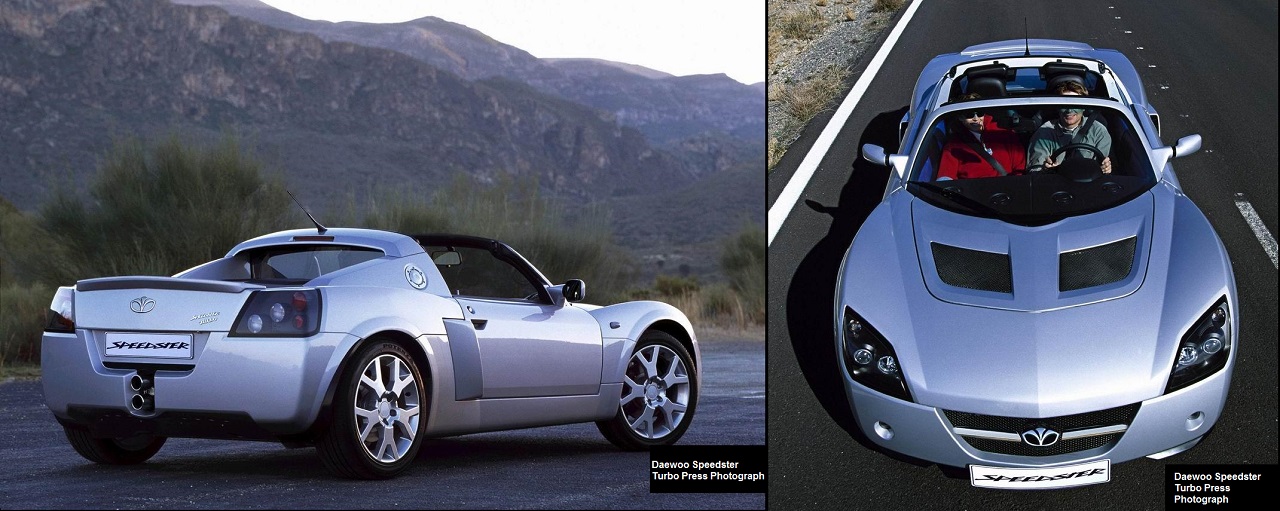
3. VAUXHALL E01 - VX220 PRESS RELEASES:

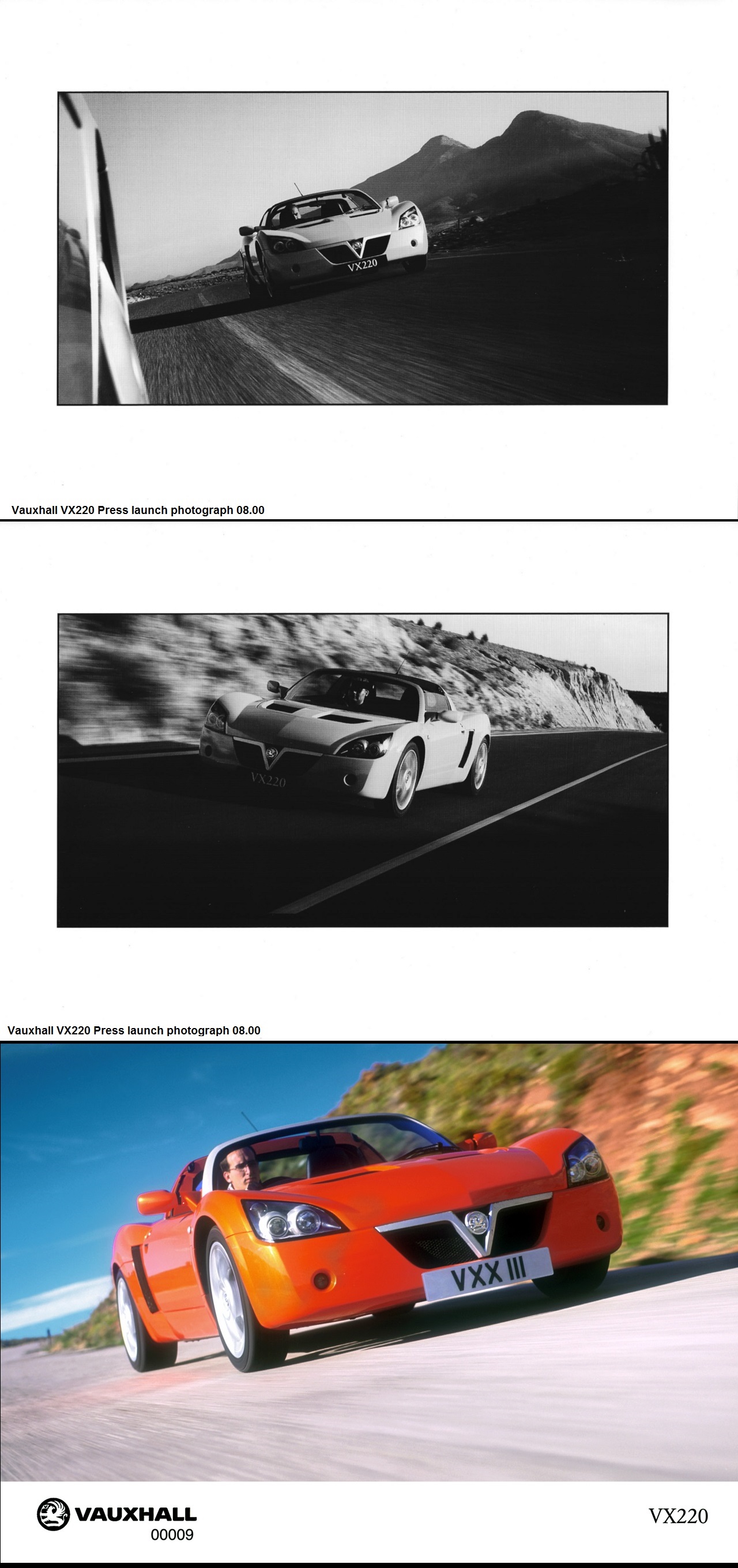



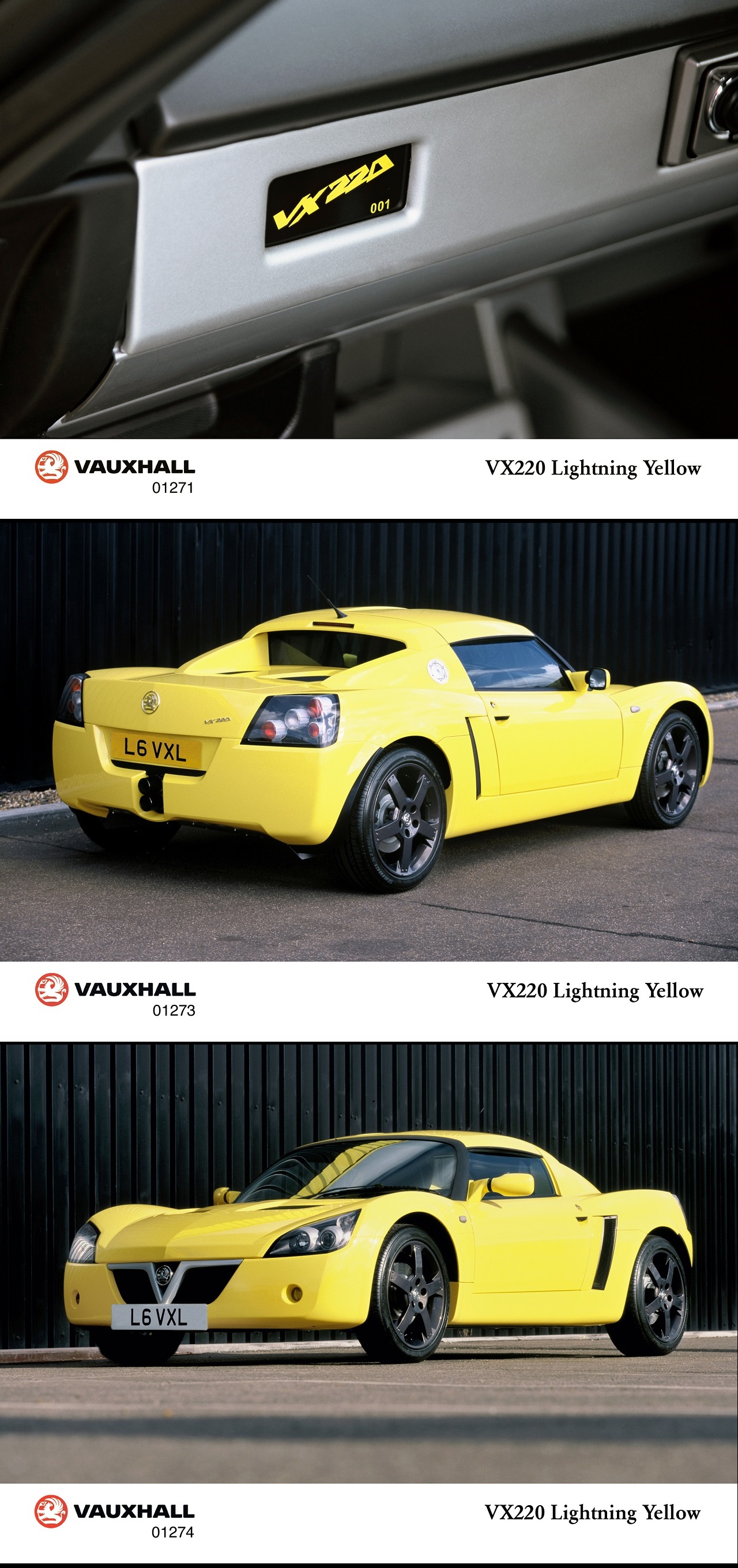

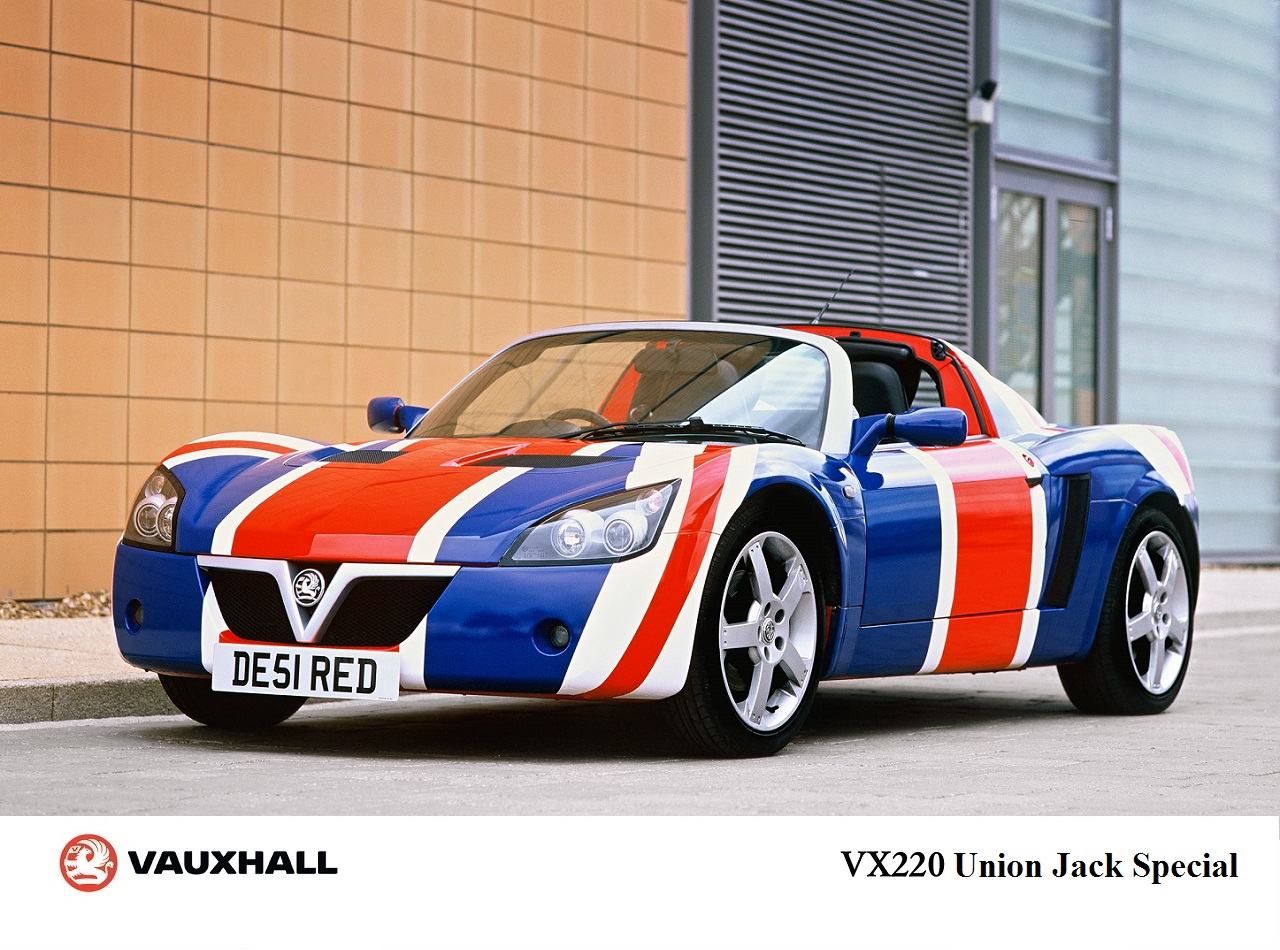



4. VAUXHALL E01 - VX220 PRESS LAUNCH ARTICLES:
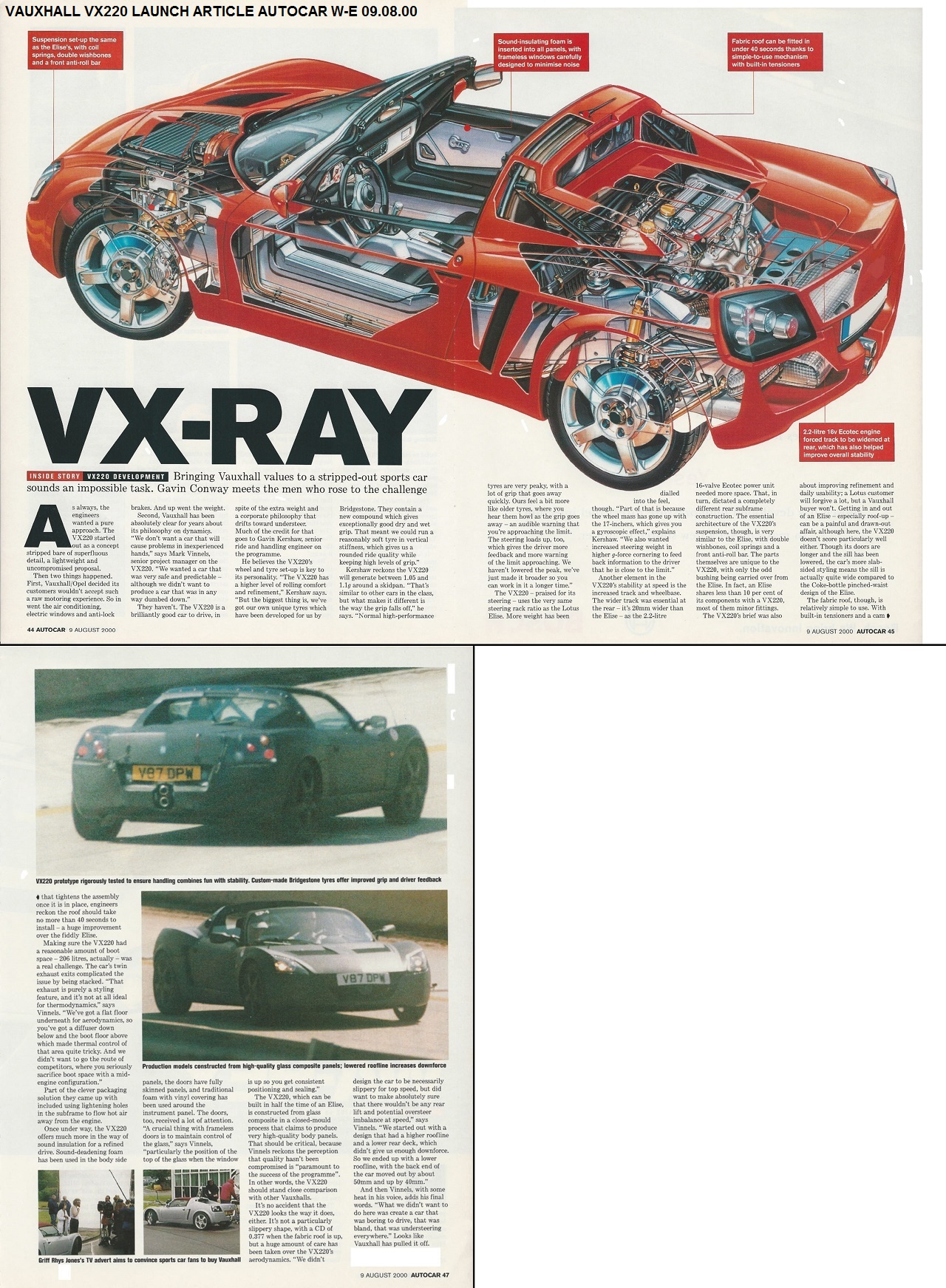

5. VAUXHALL E01 - VX220 BROCHURES:will be saved.


